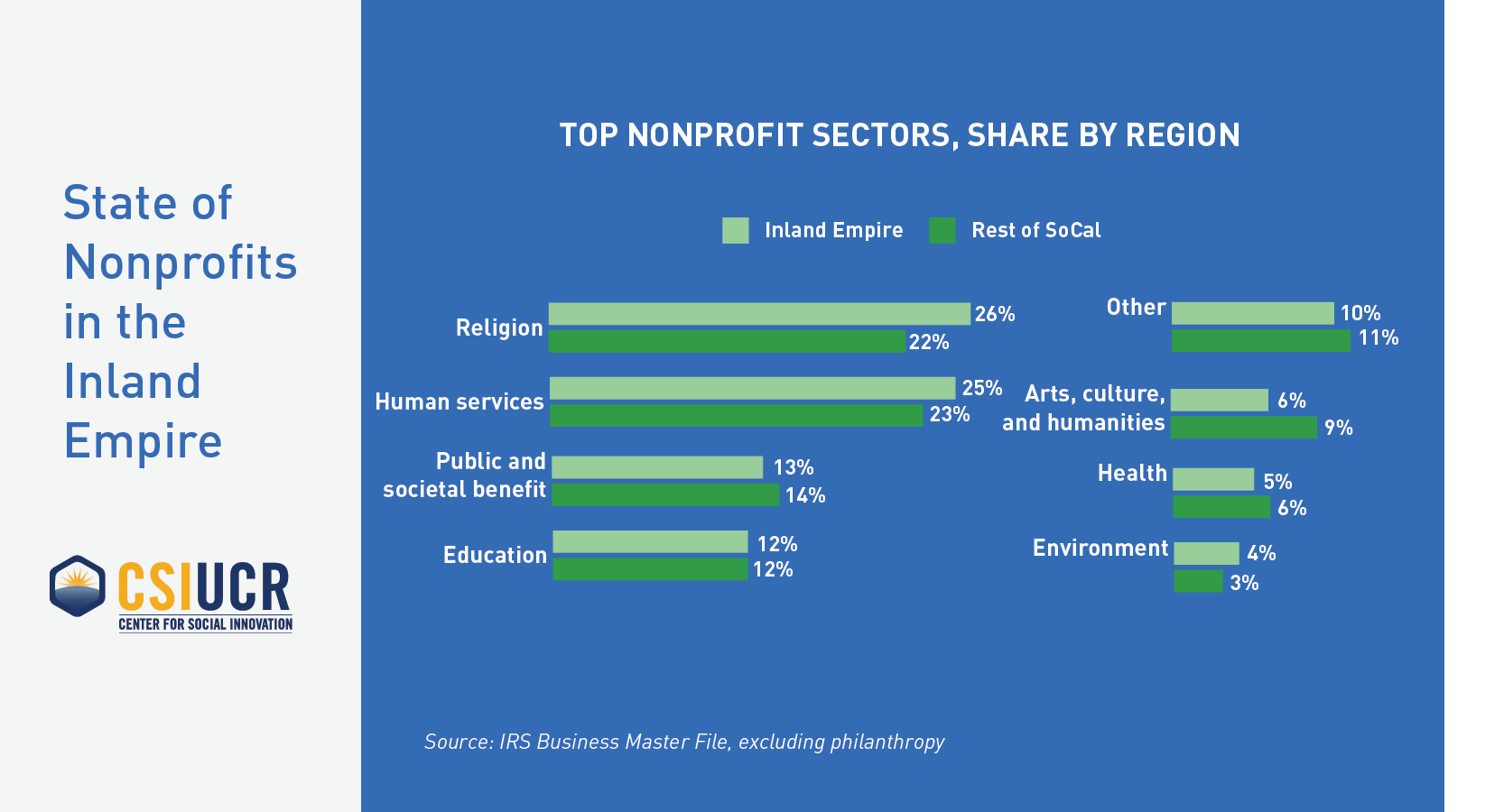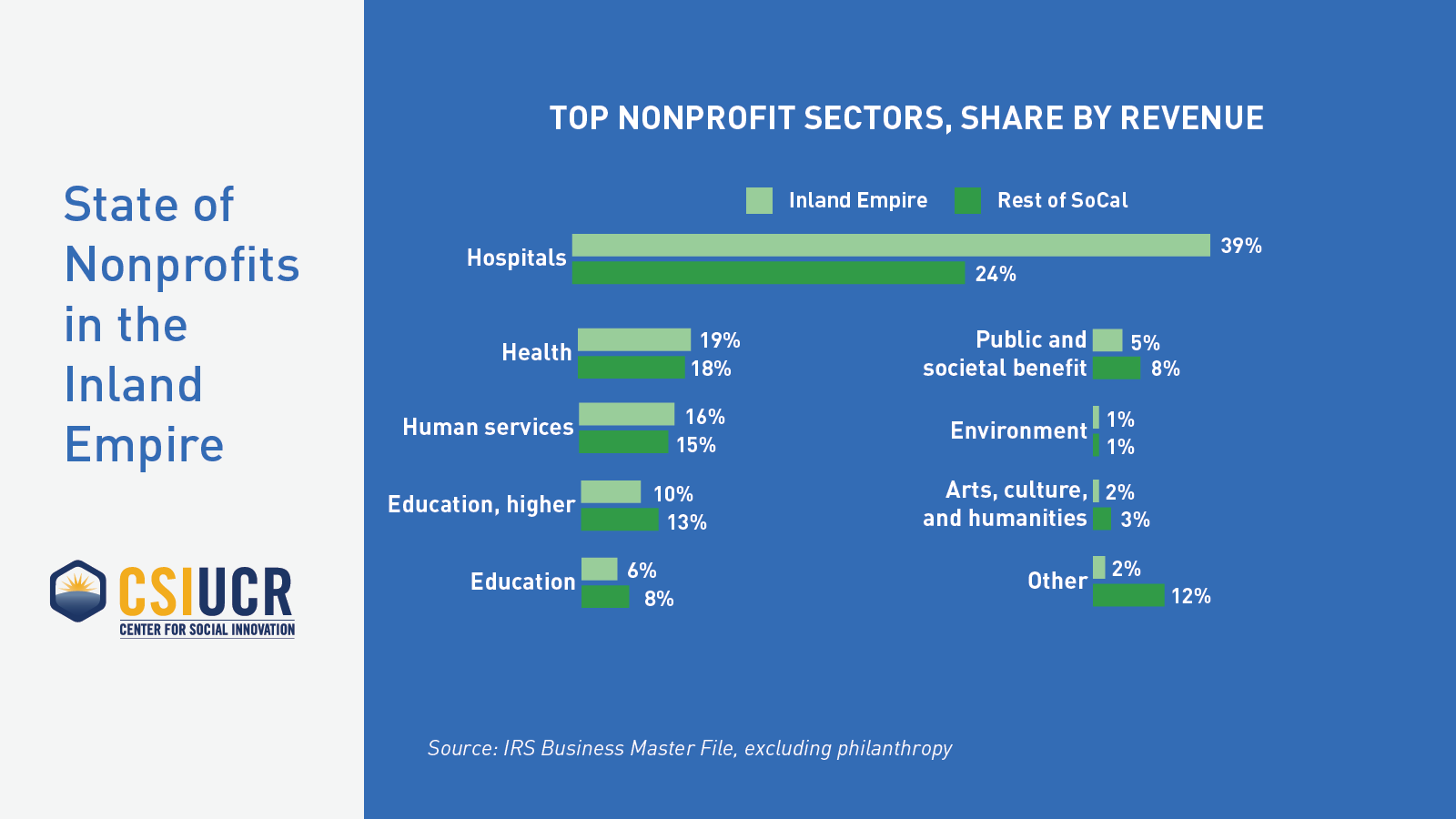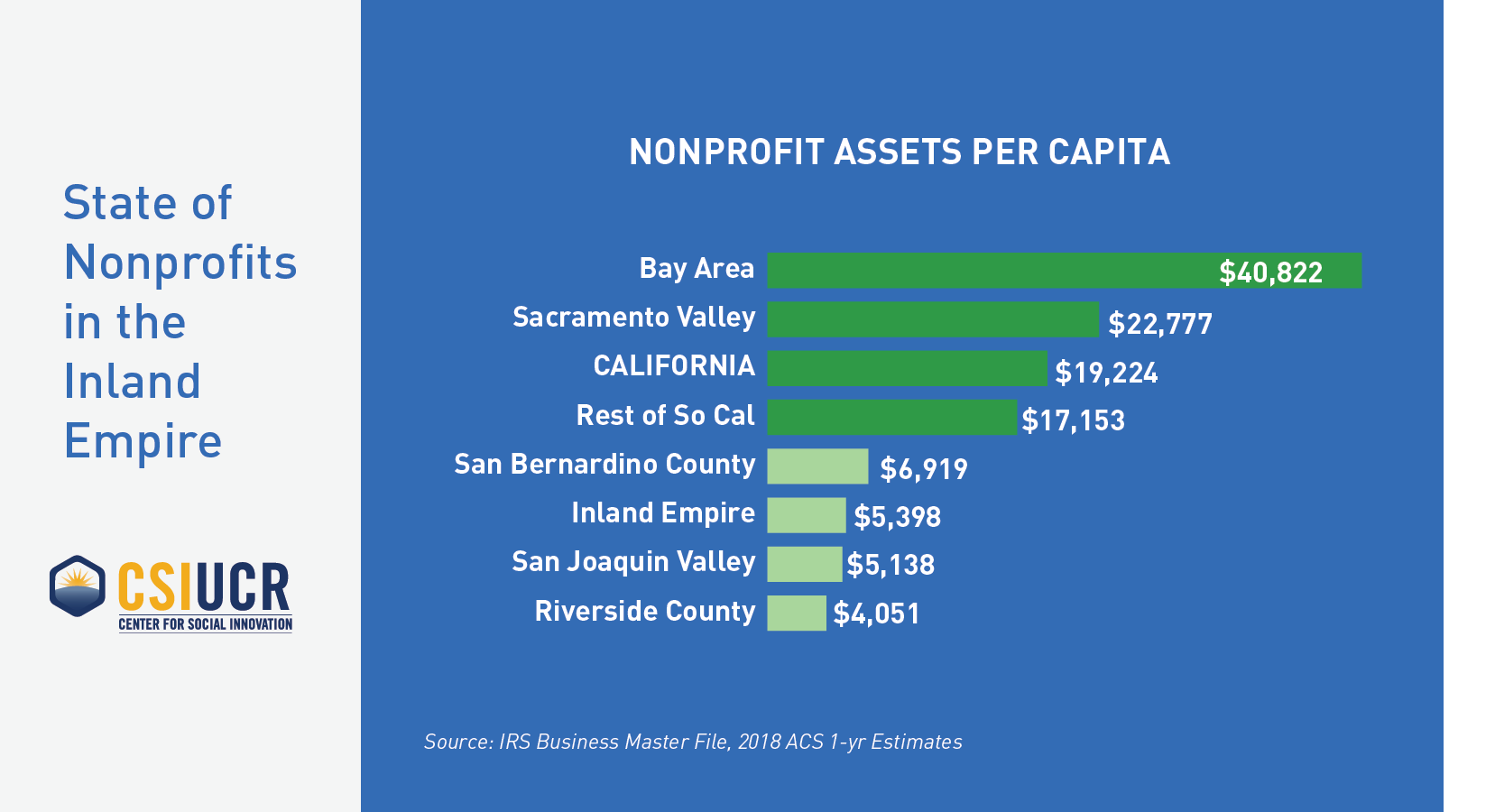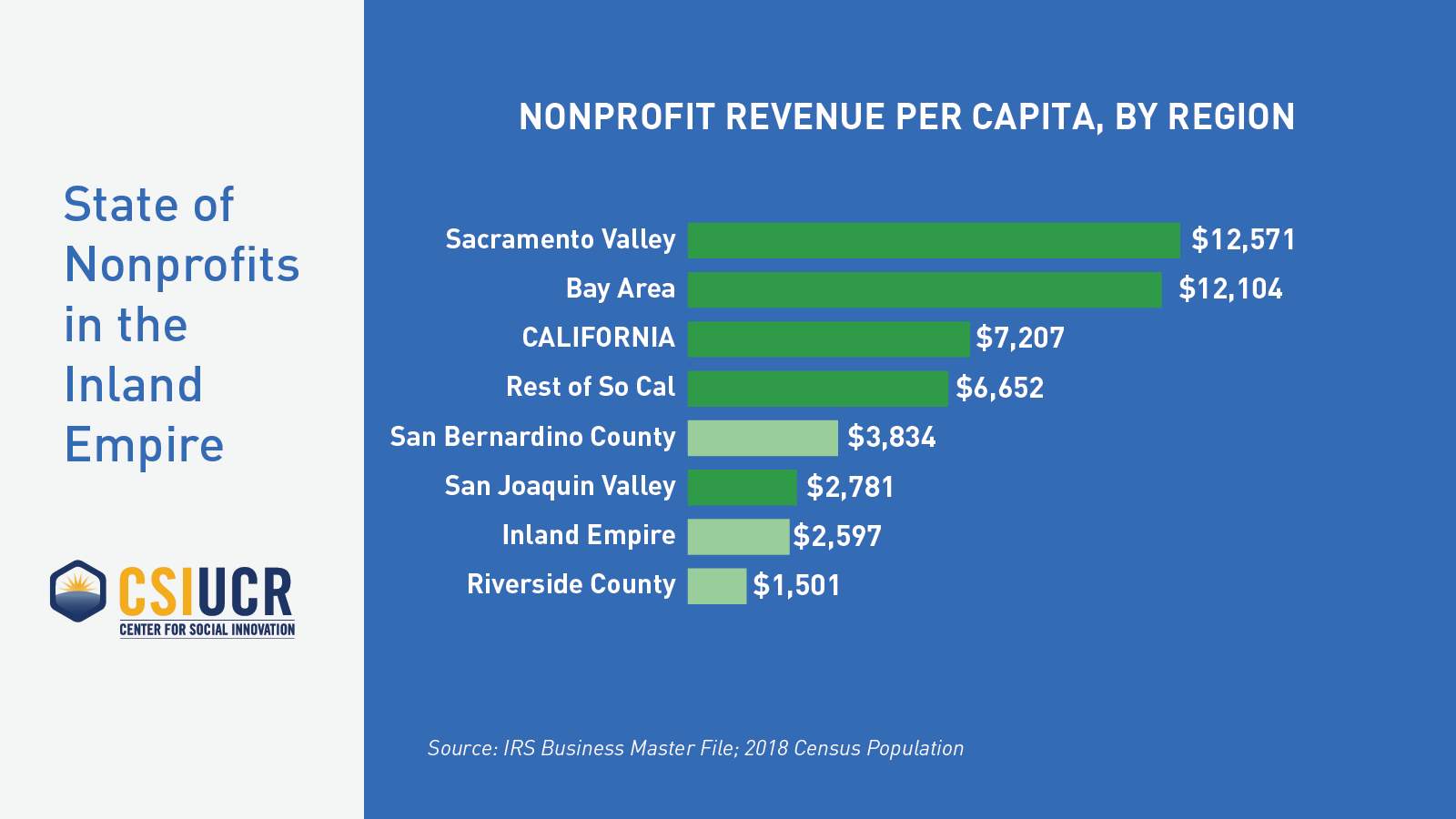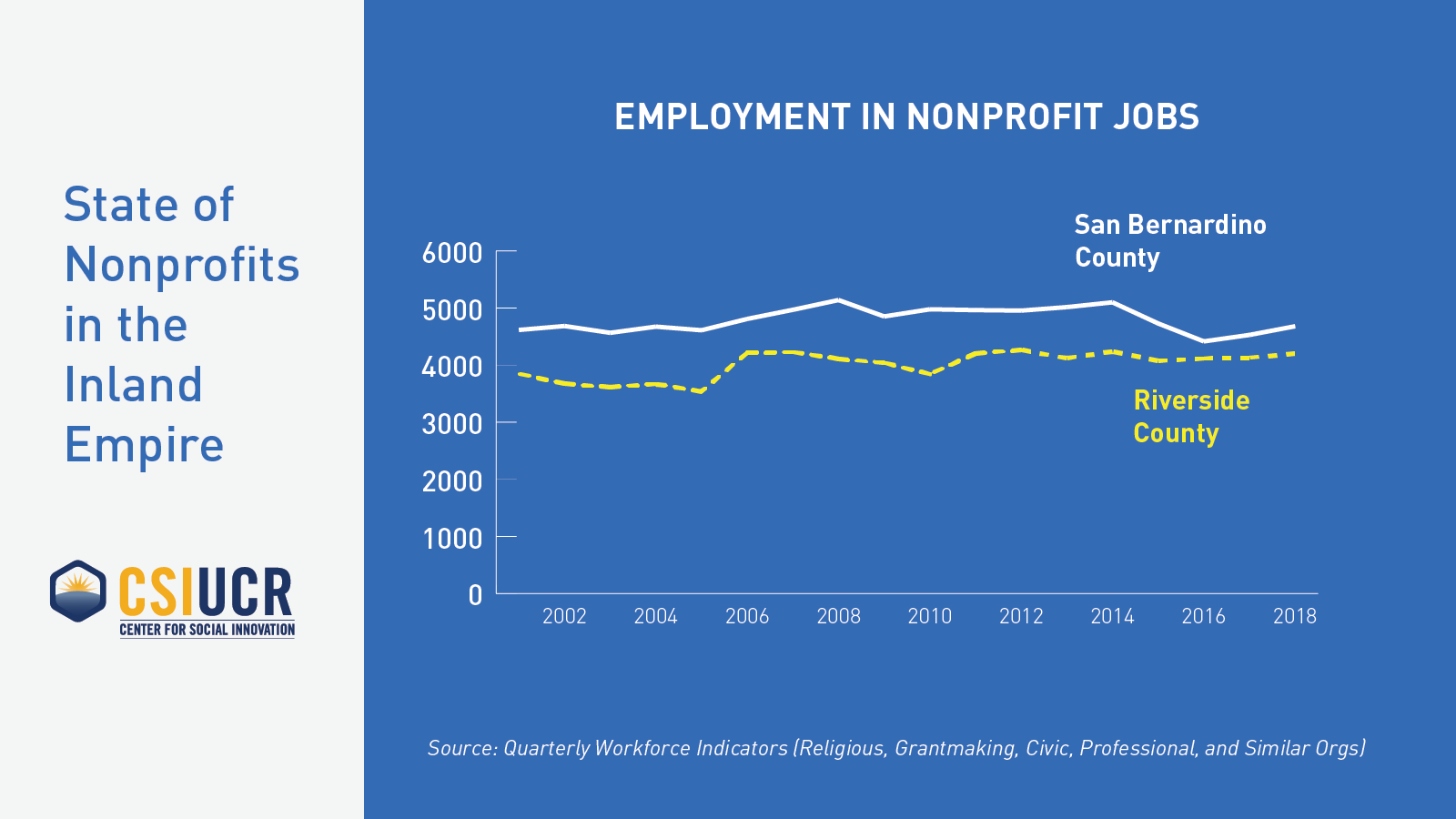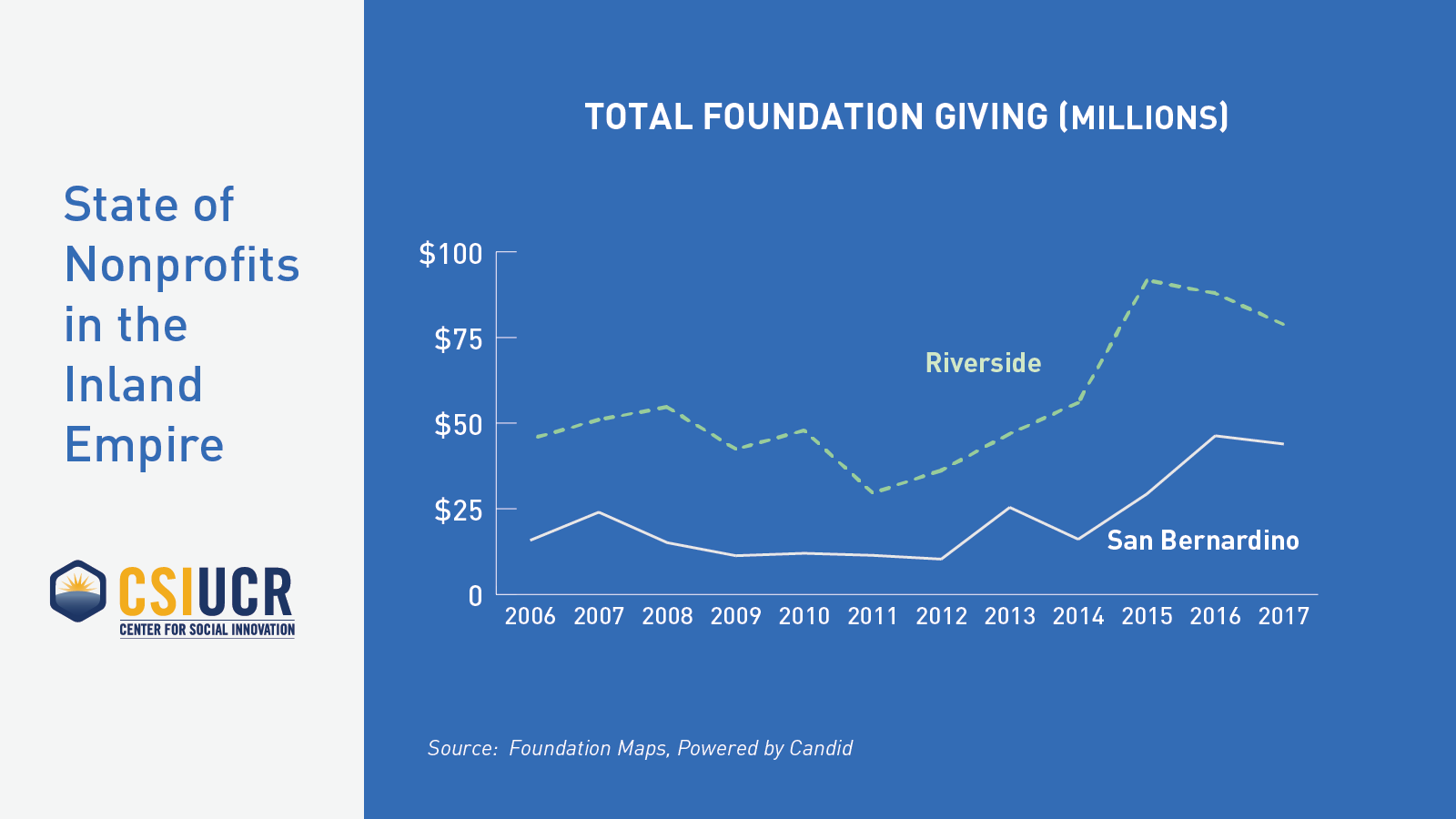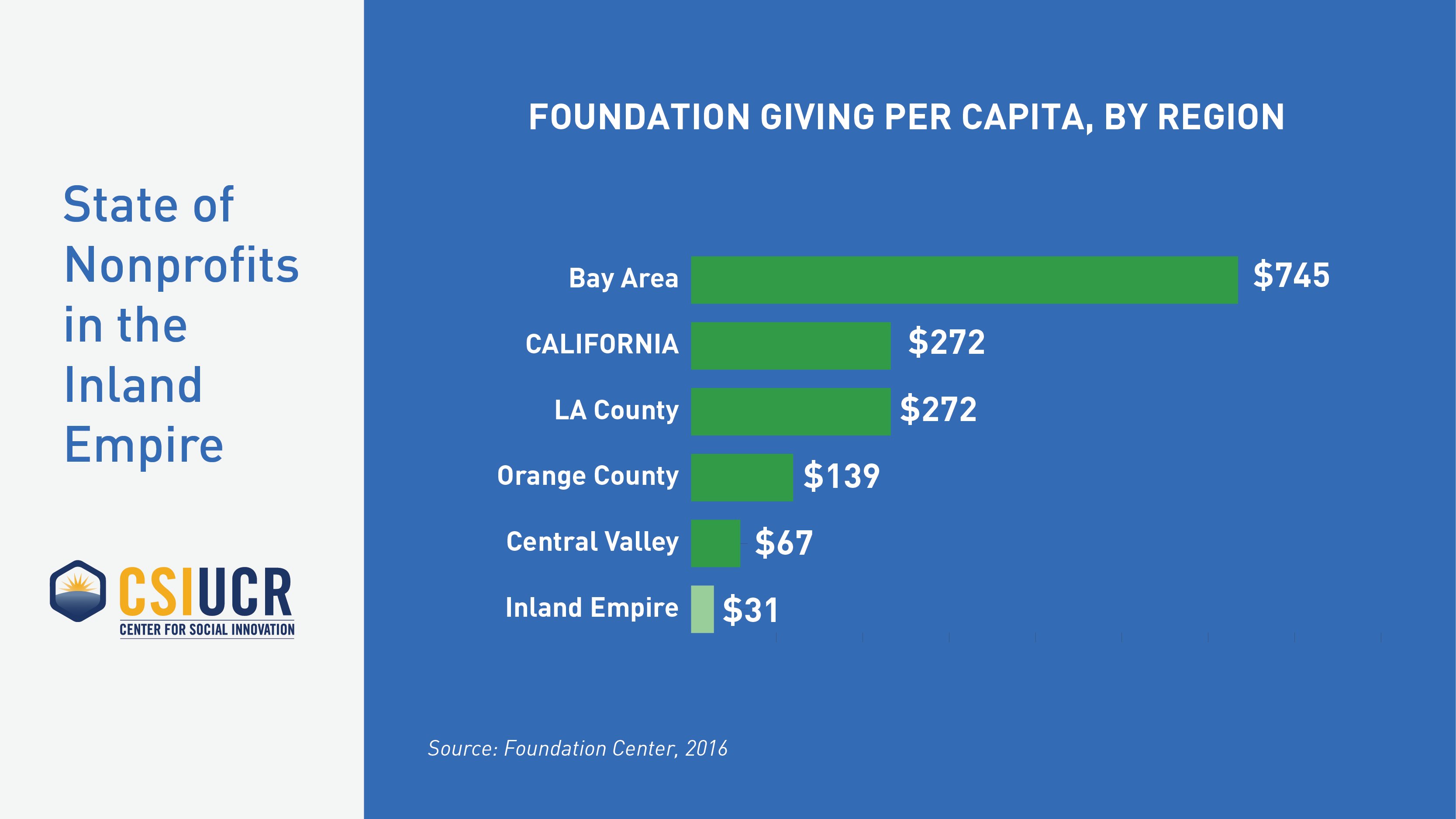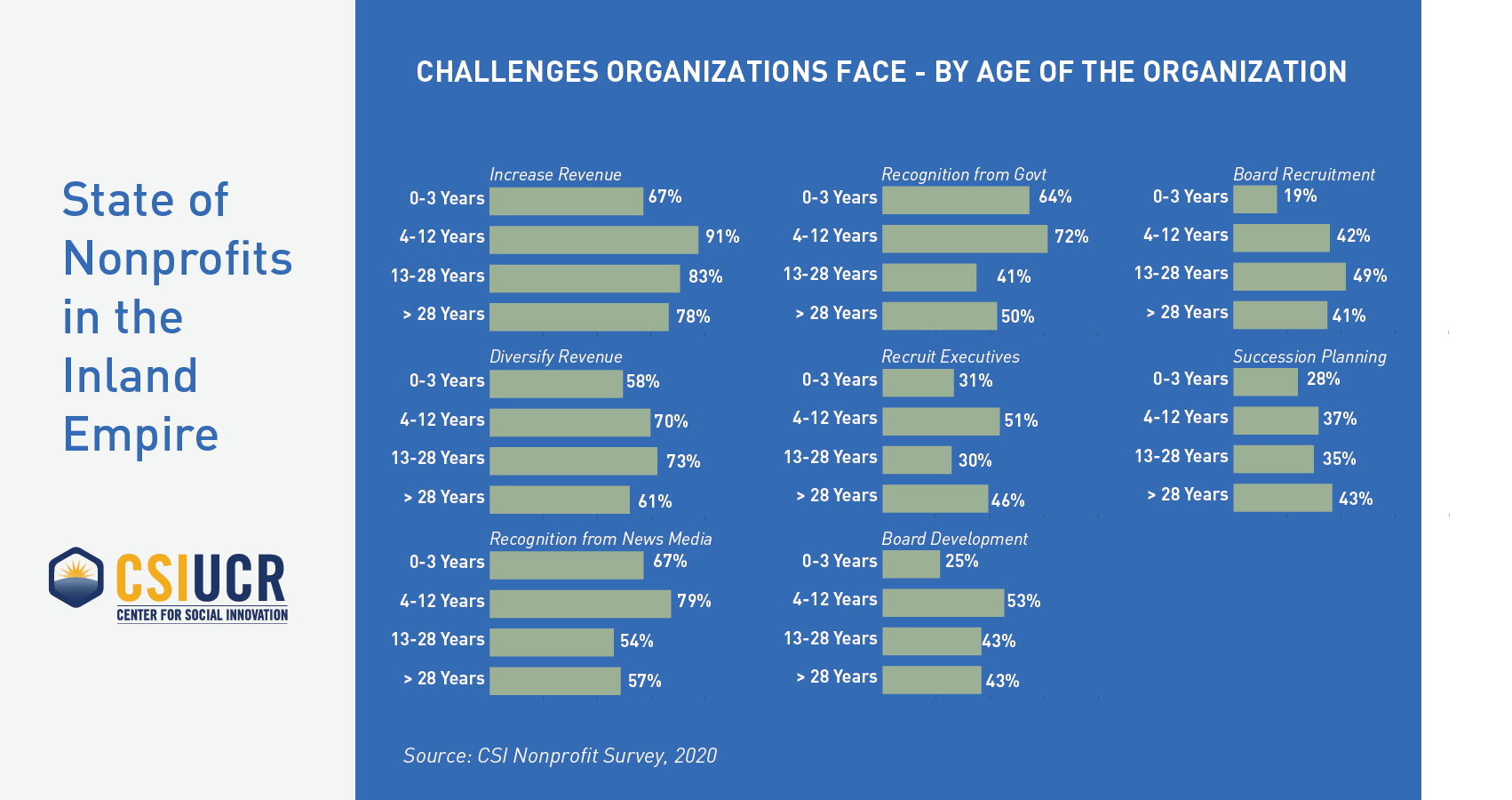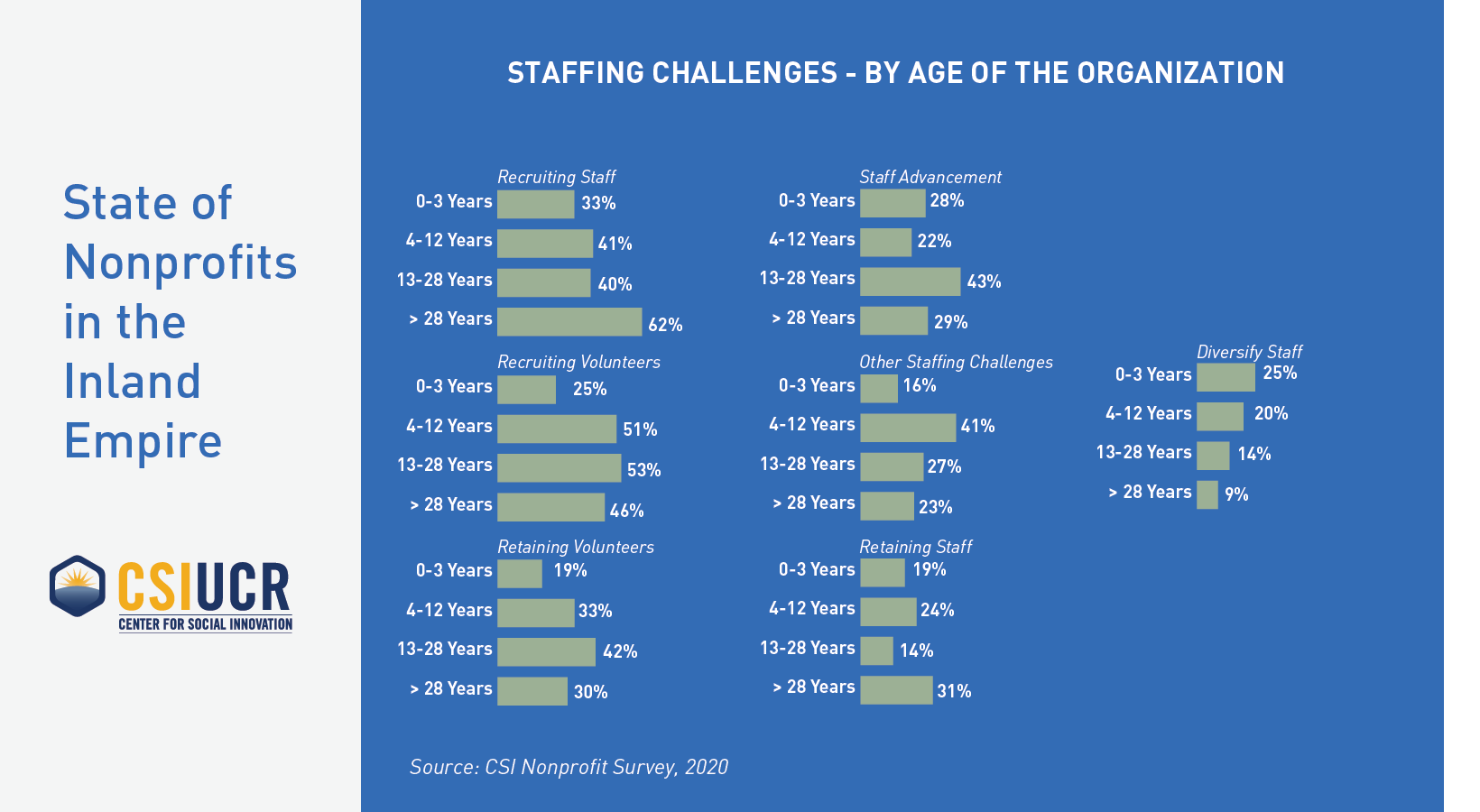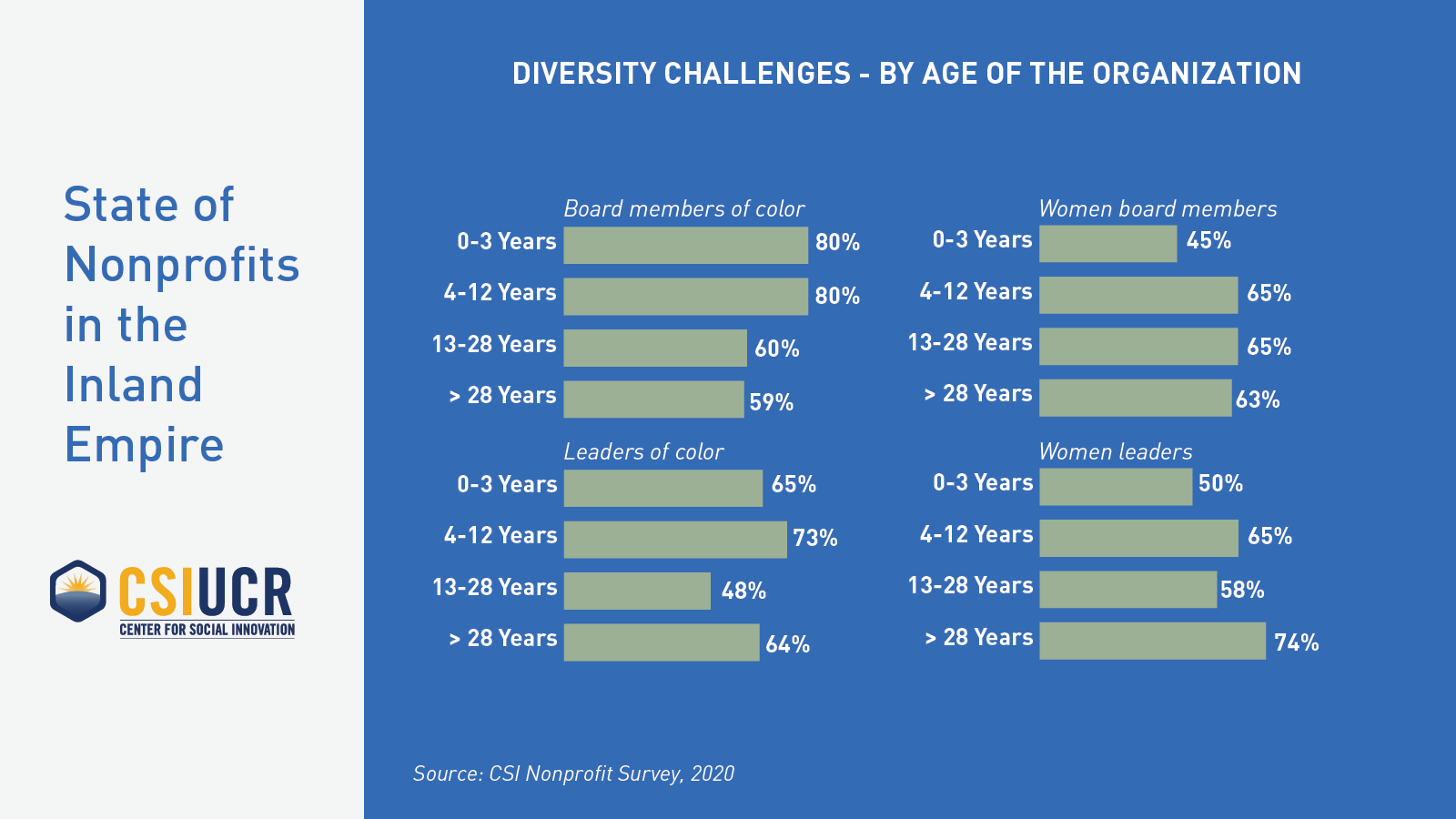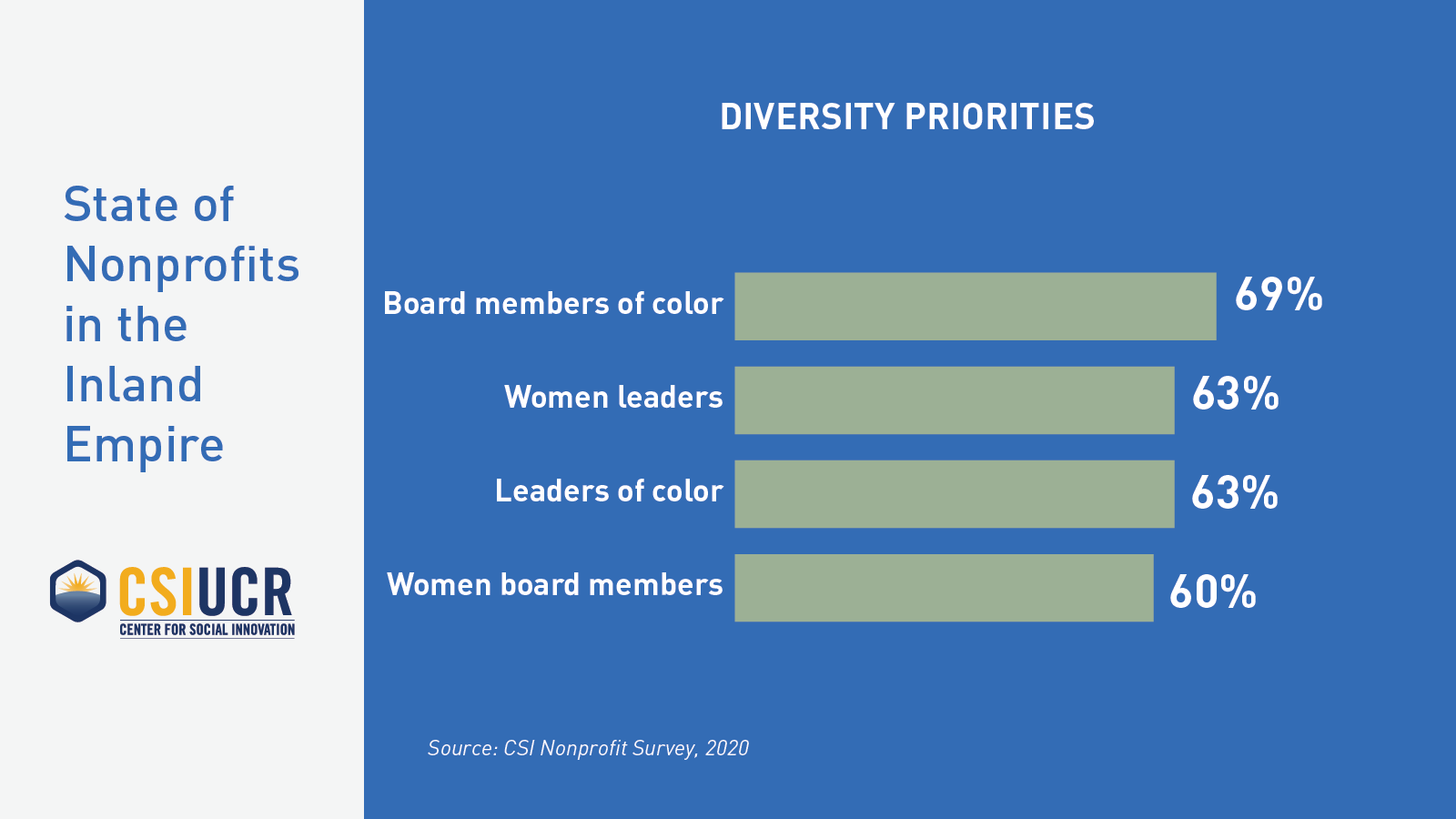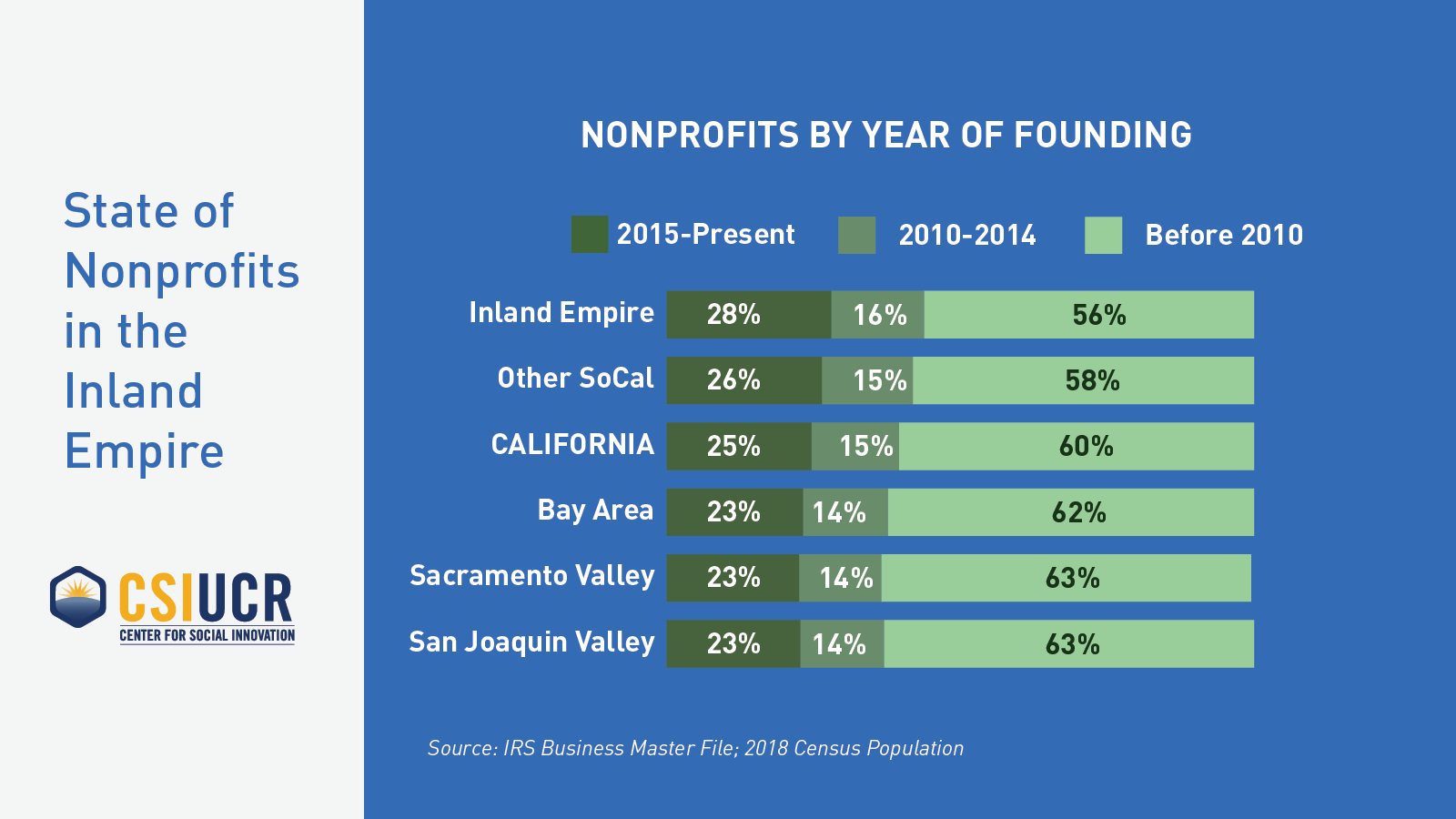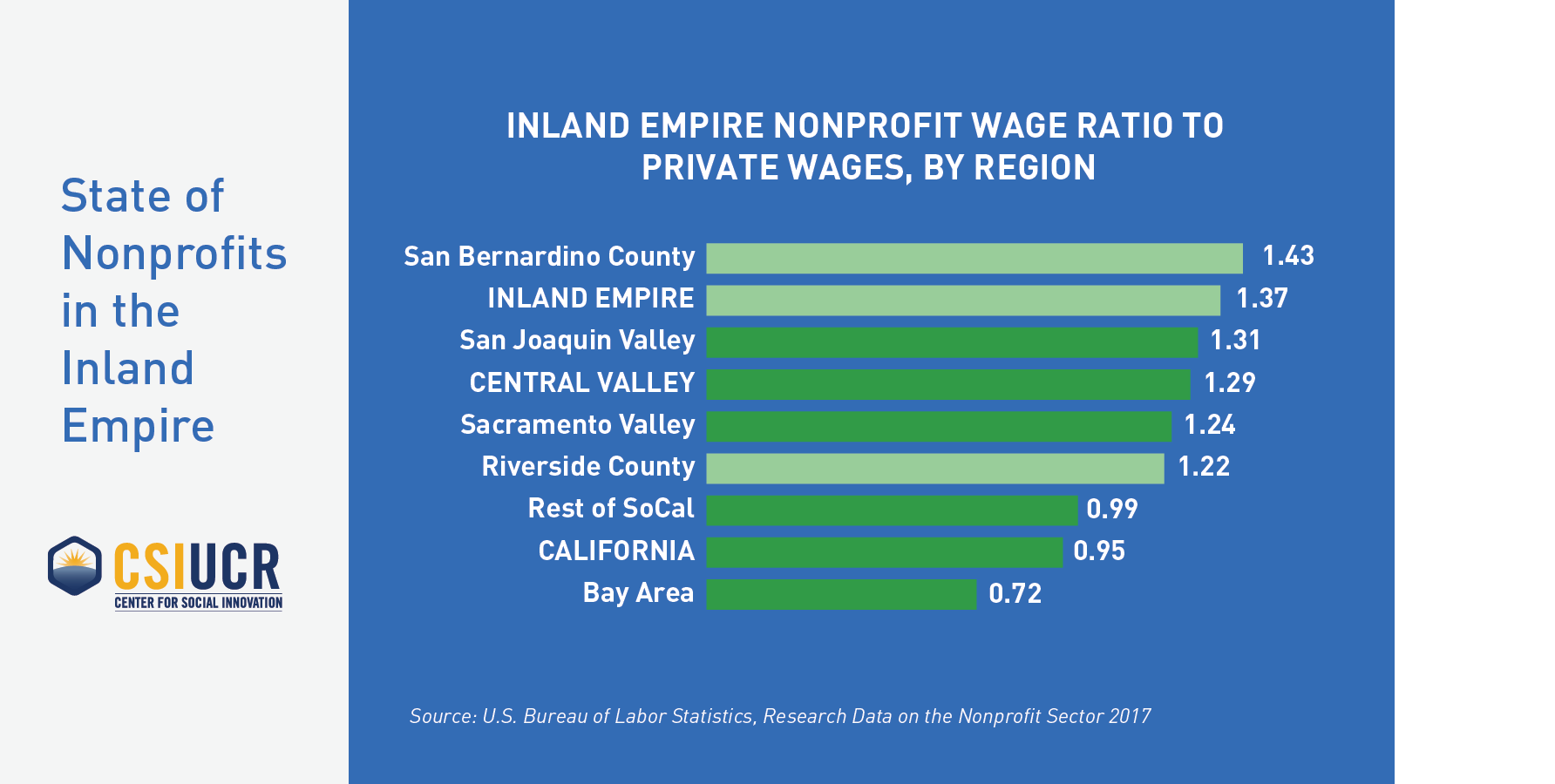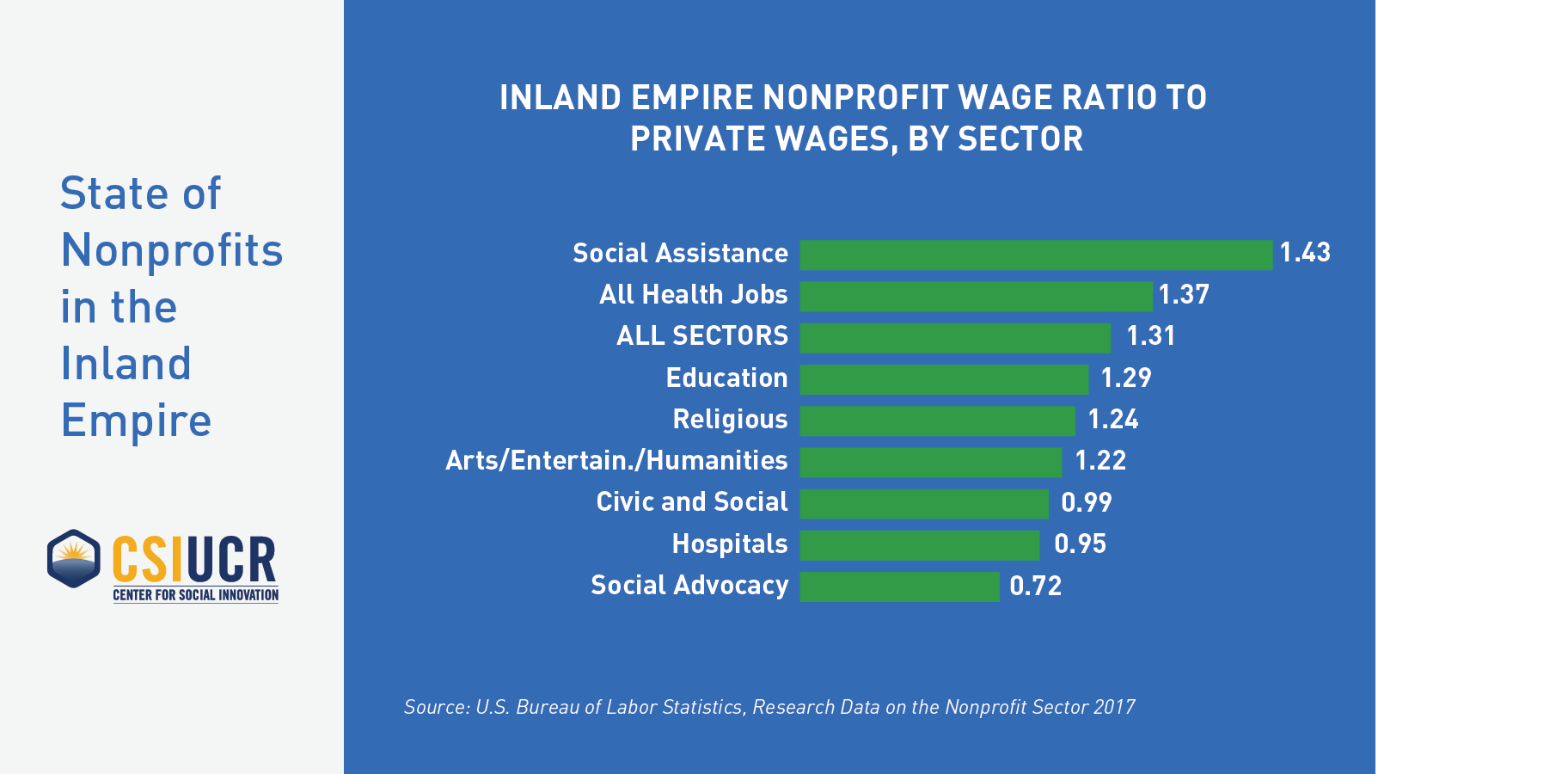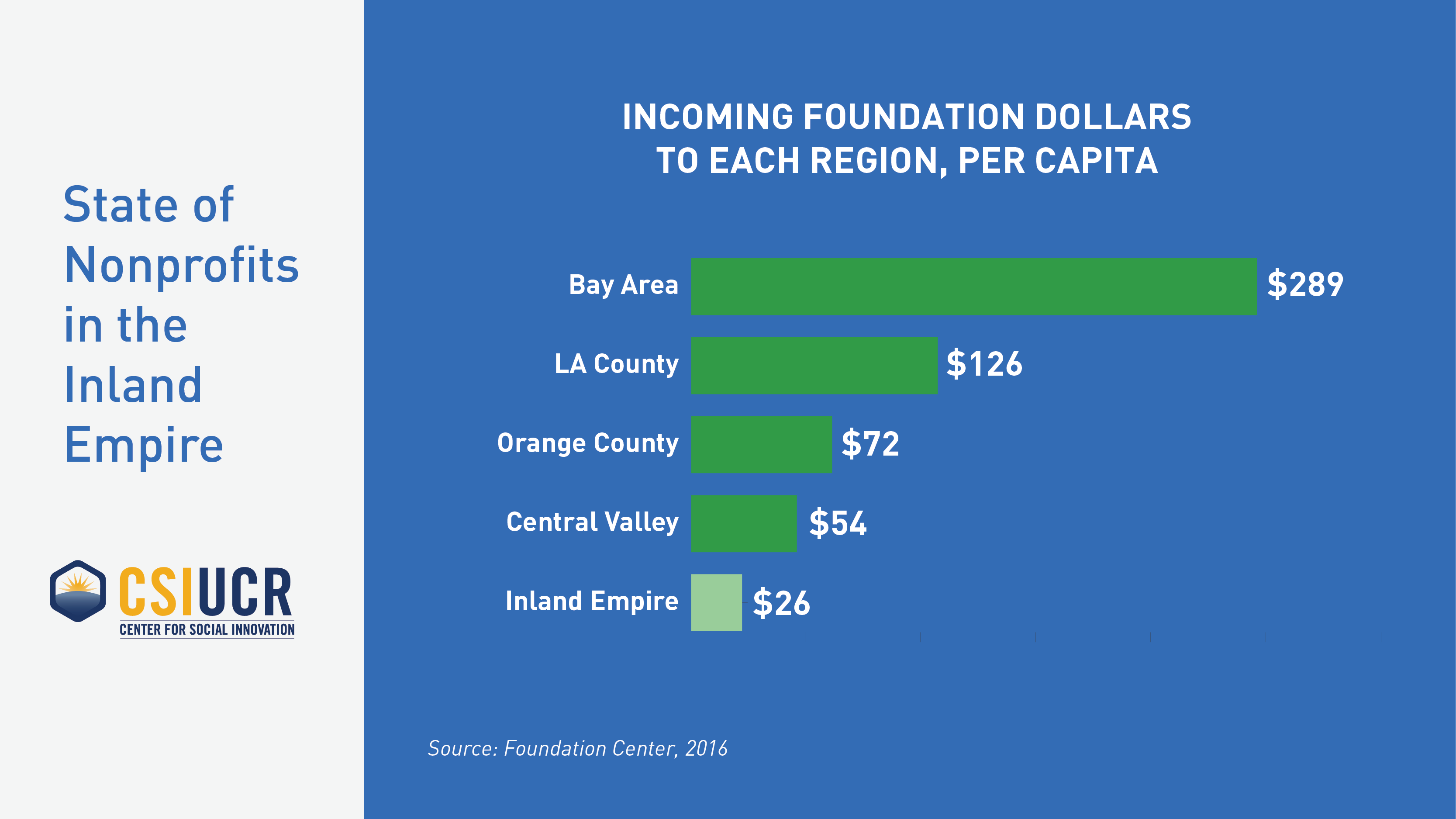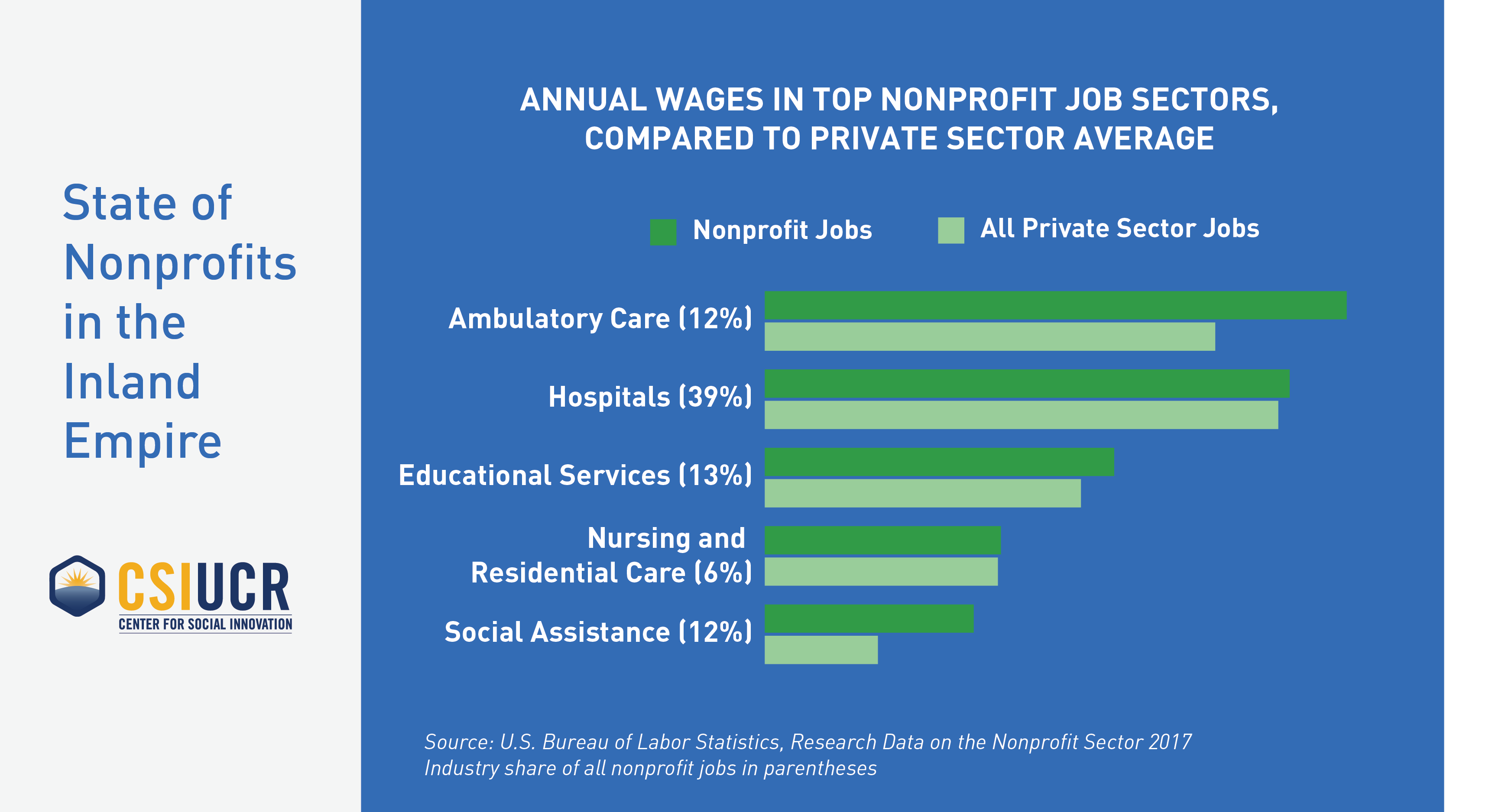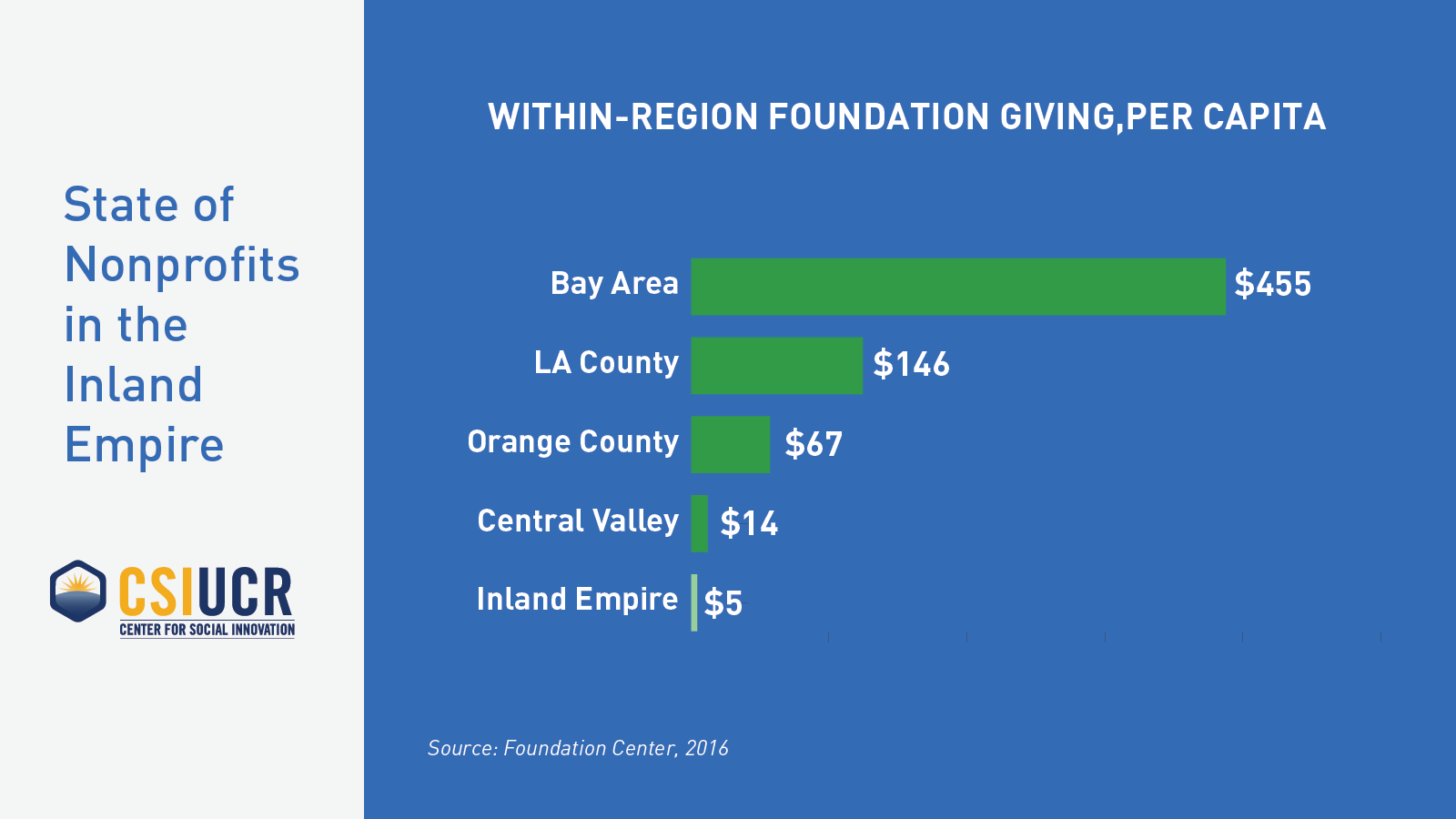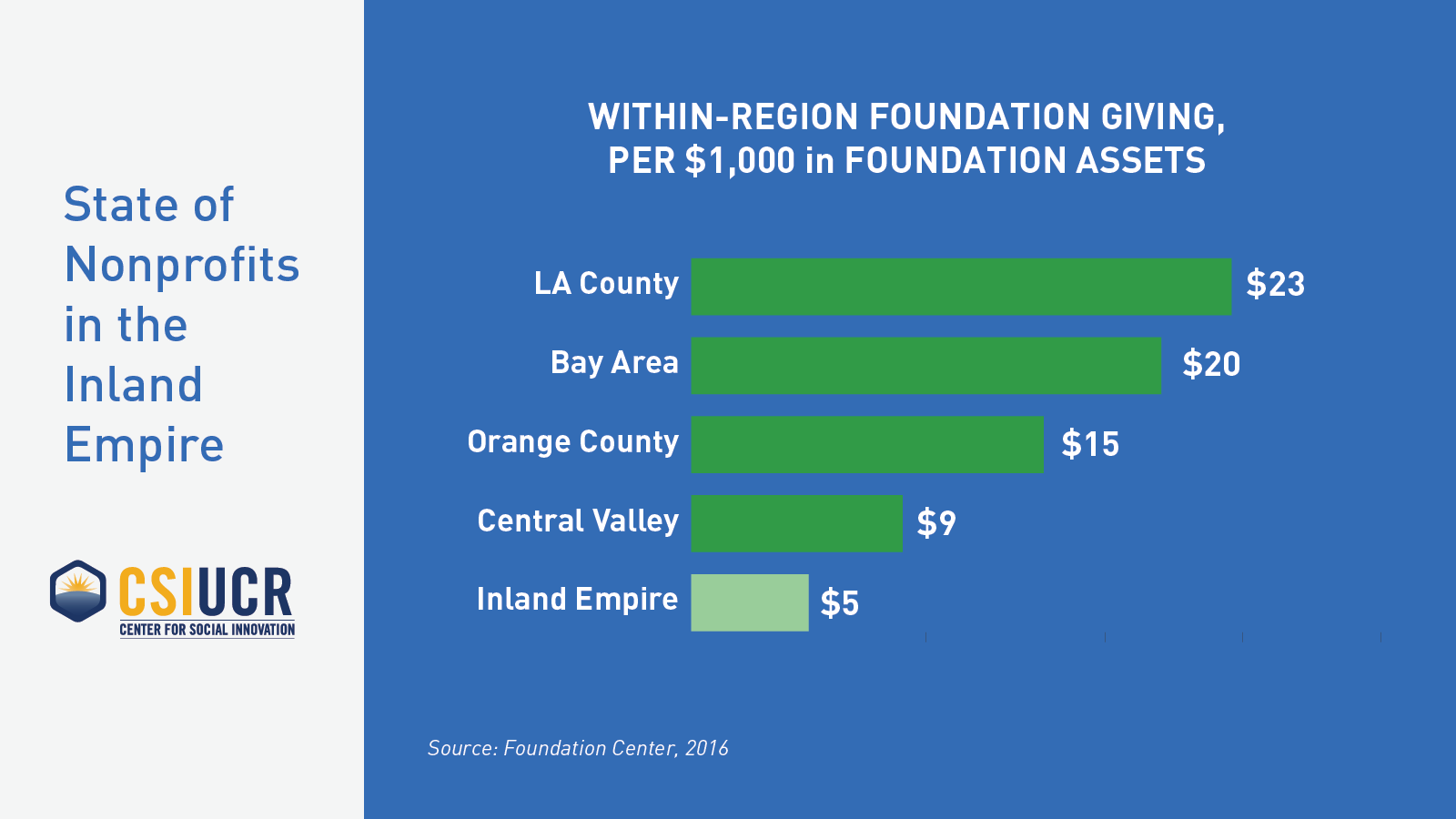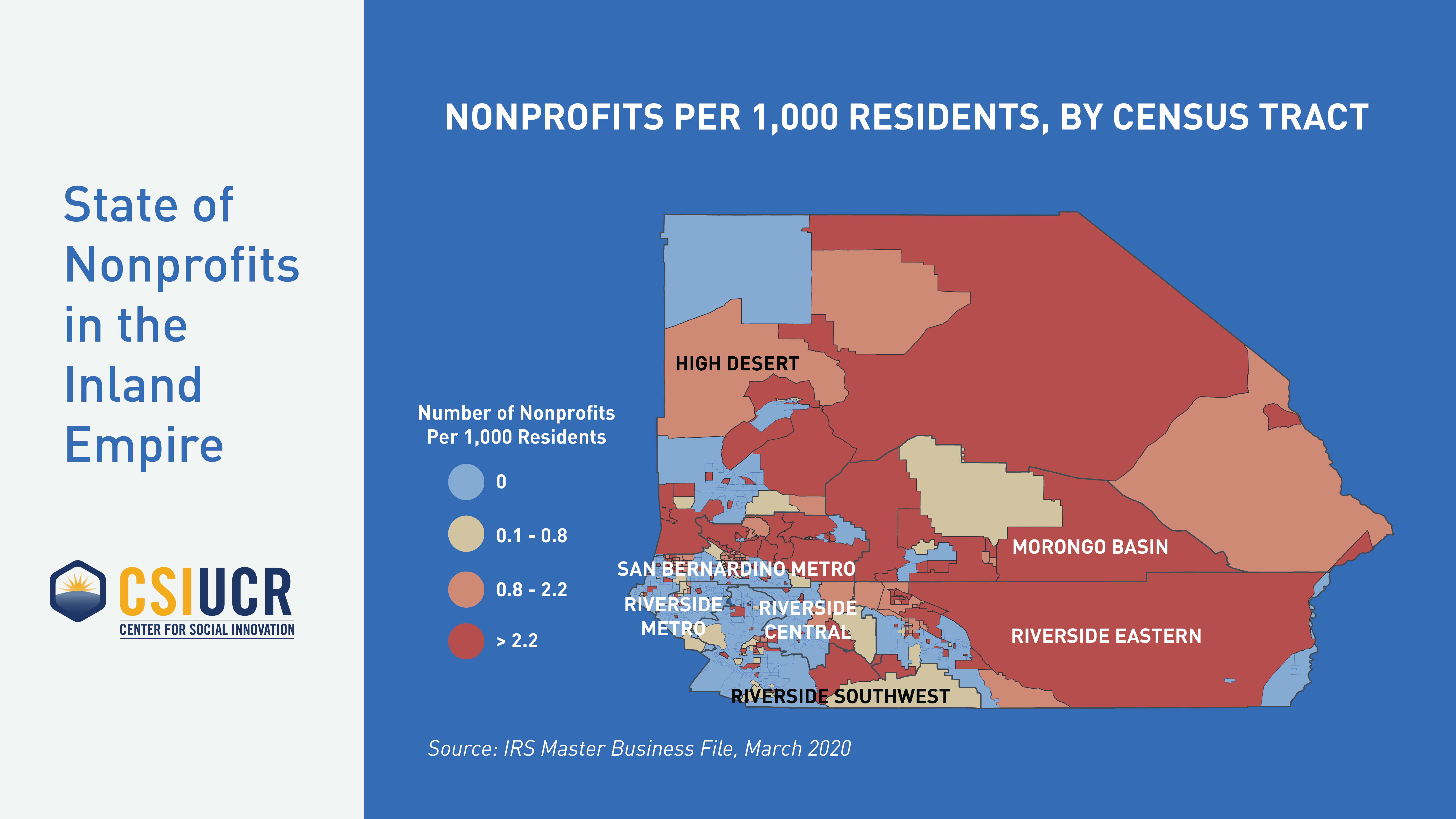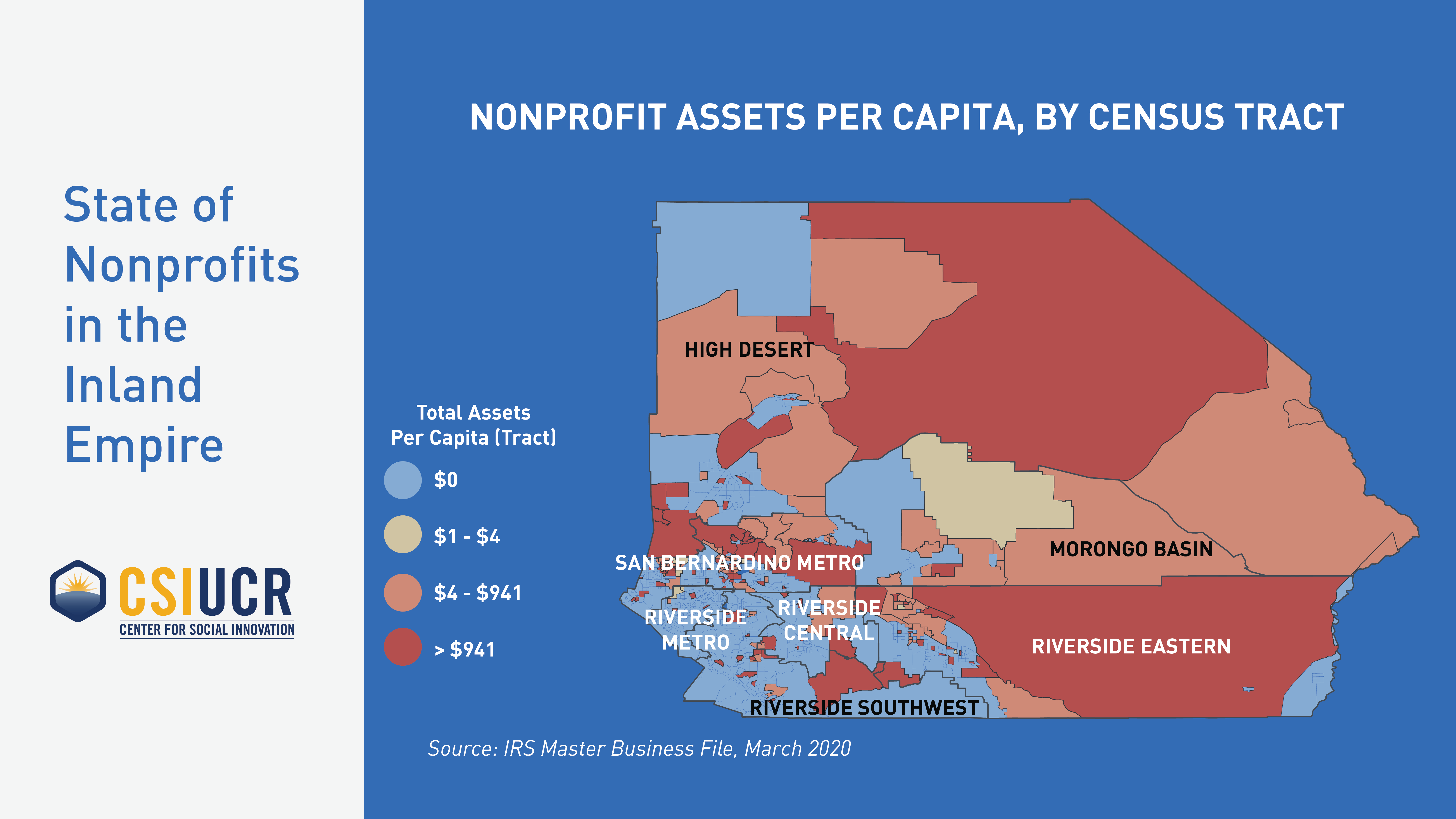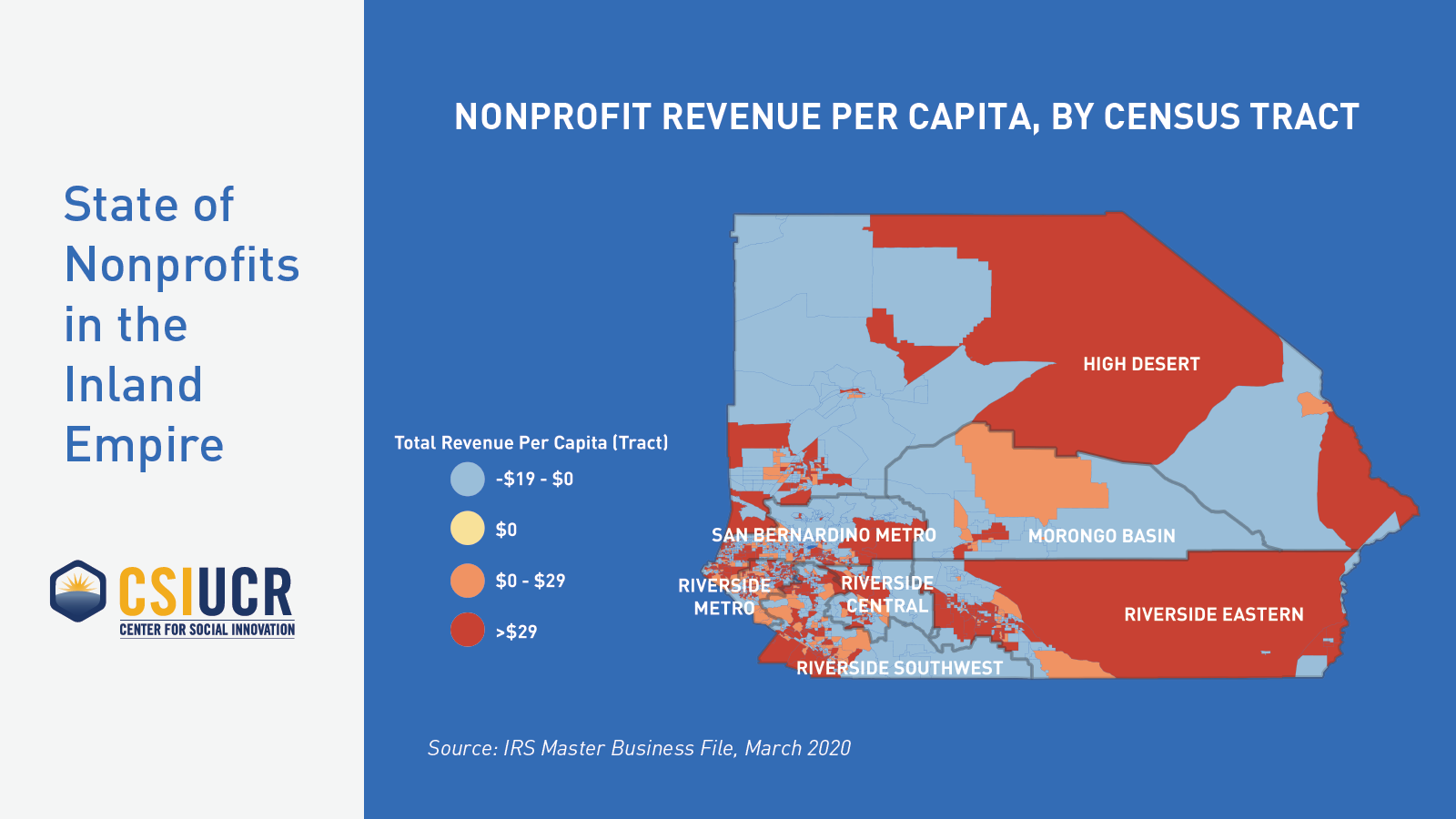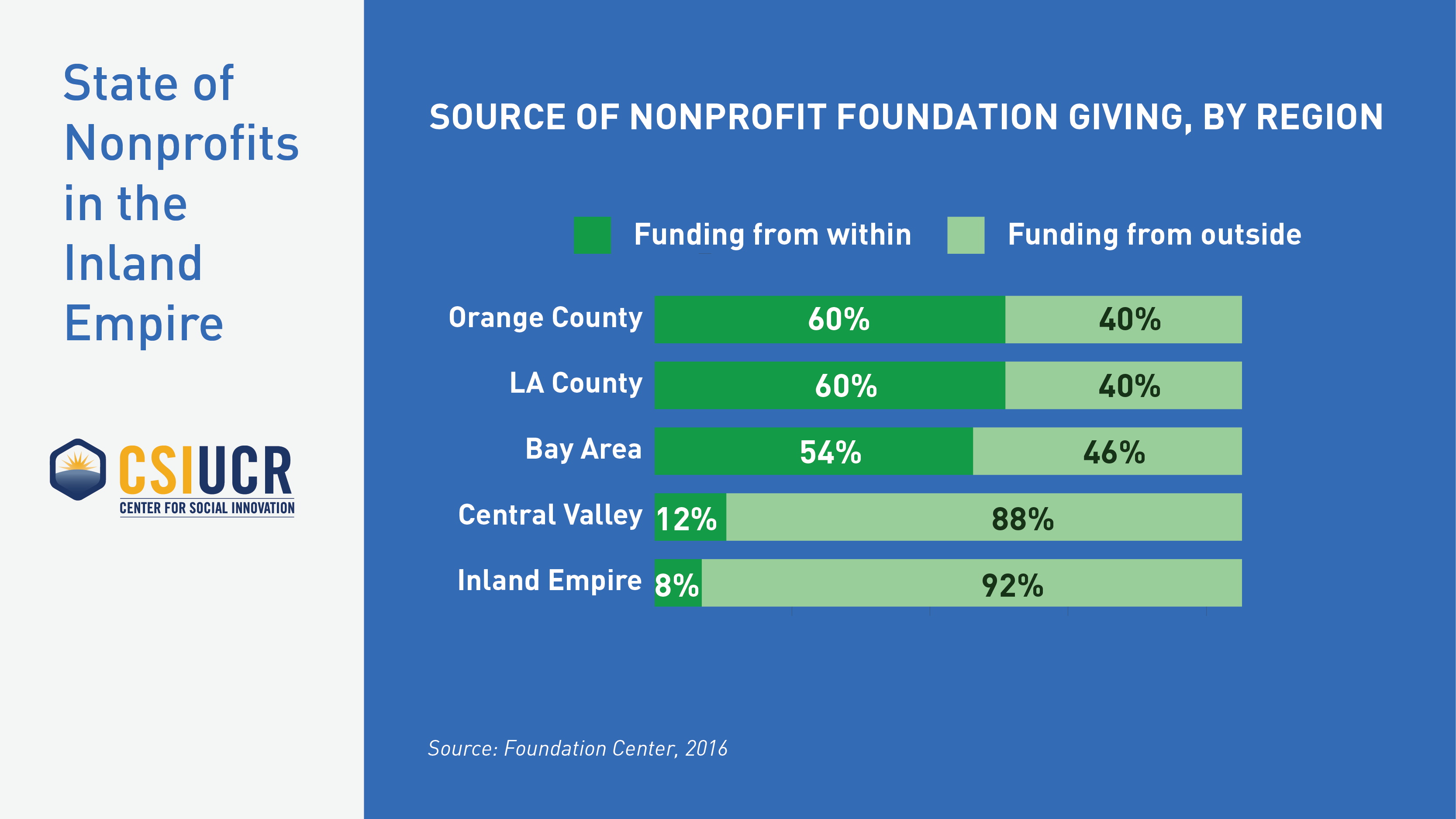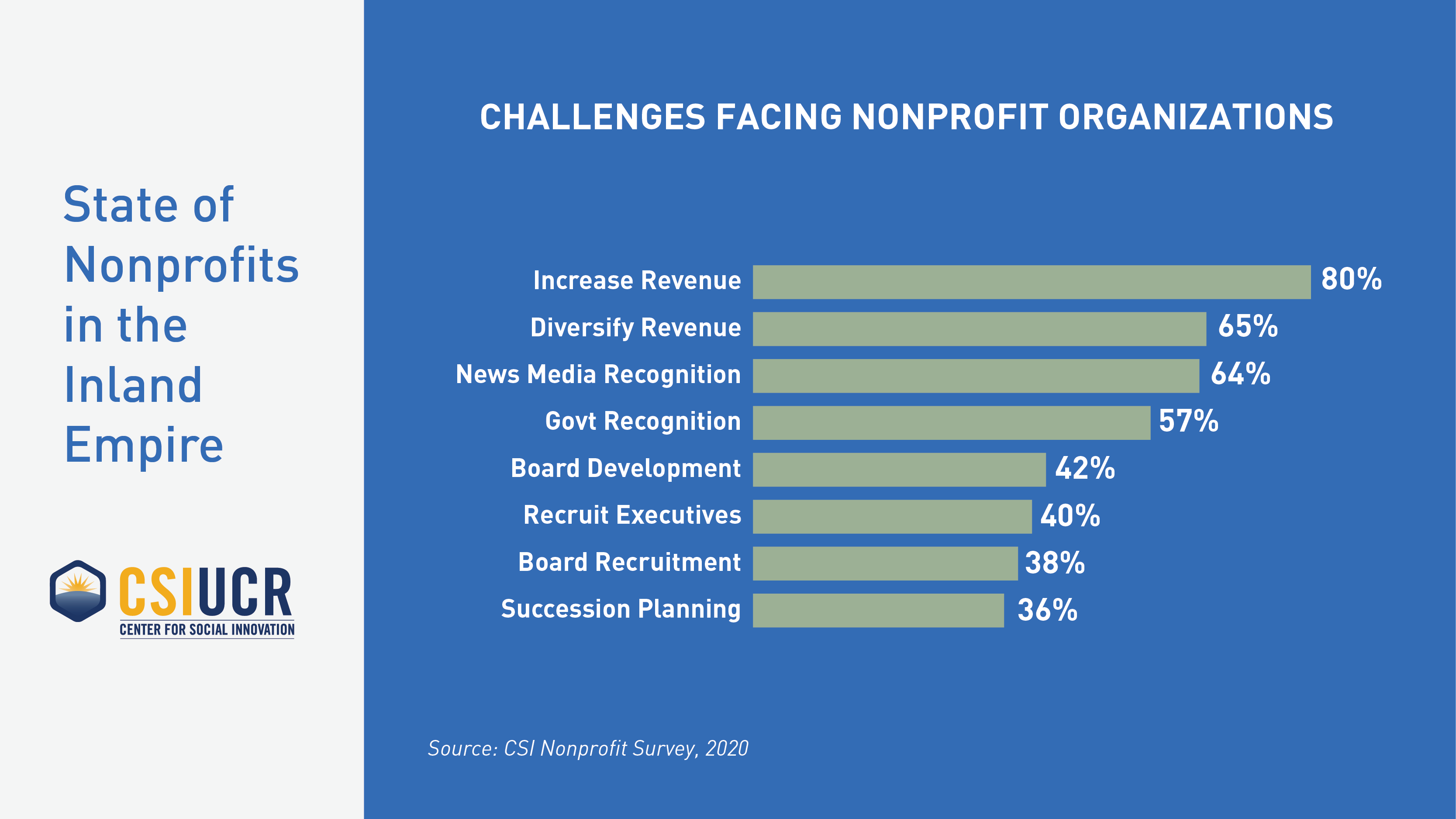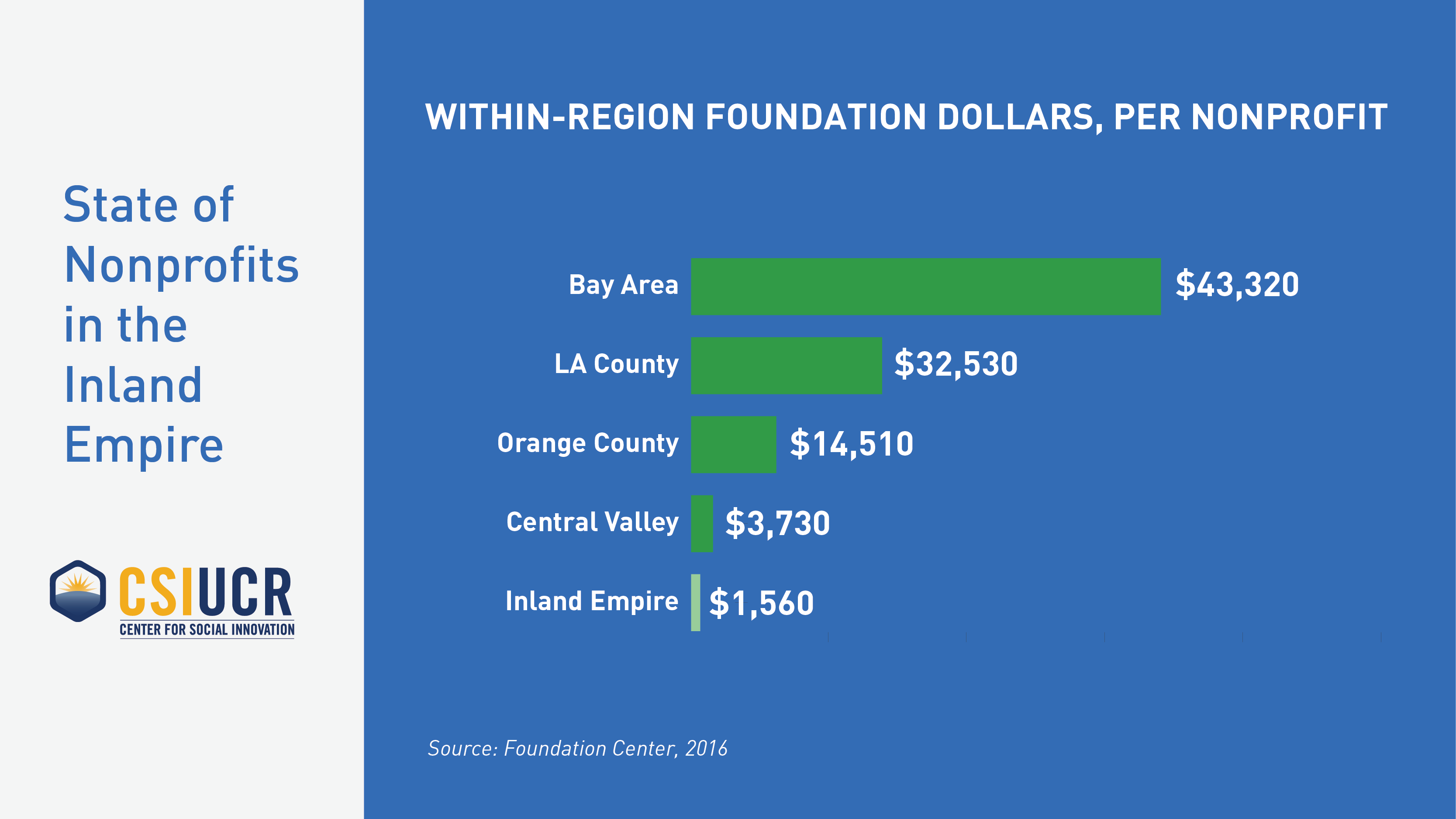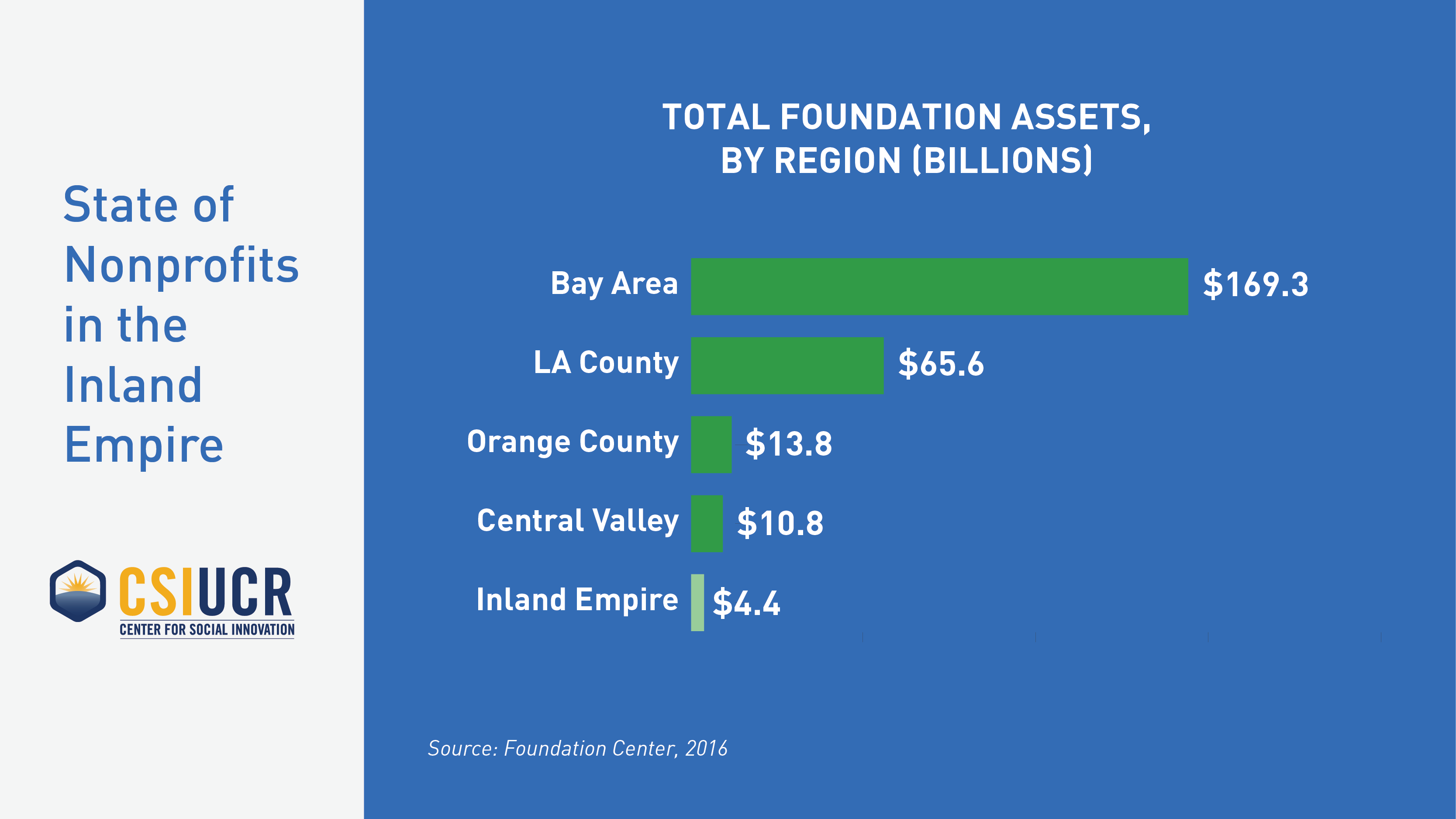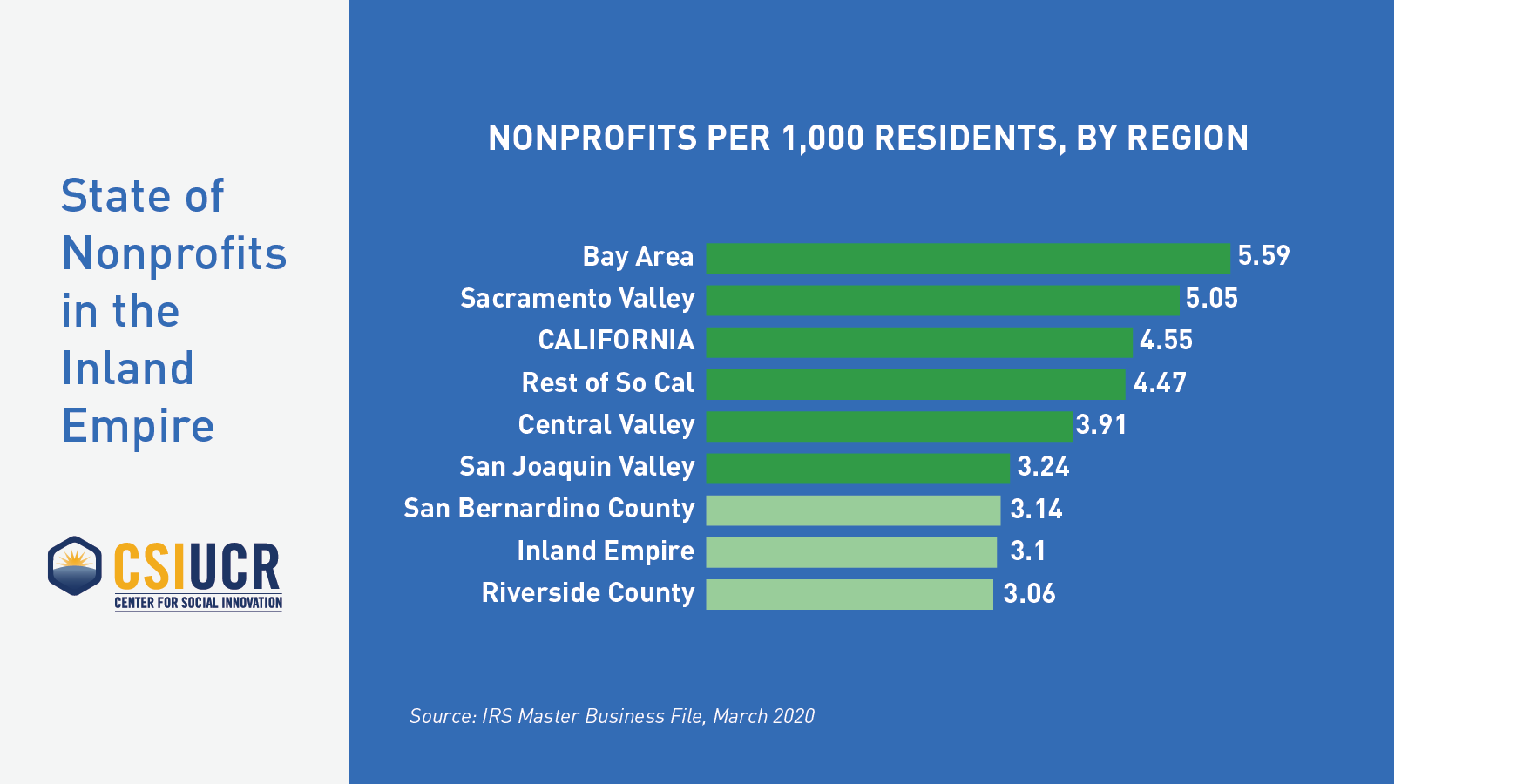Center for Social Innovation
State of Nonprofits in the Inland Empire
The future of California is inland, and the future of Southern California is the Inland Empire. As the two-county region of 4.6 million residents continues to grow, a strong and vibrant nonprofit sector is essential to ensure a more inclusive and sustainable economy and society. The state of nonprofits in the Inland Empire is improving in several respects, based on our analysis of IRS data on nonprofits, foundation giving data, employment data, and our surveys and interviews with regional nonprofit leaders. Boosting public and private investments in the region’s nonprofits is especially critical post-2020, given the context of a post-Census drop in funding to grassroots organizations and the economic havoc of COVID-19 that disproportionately hurts low-wage workers and communities heavily reliant on hospitality and retail. Boosting funding in the Inland Empire is not just a matter of need, but also one of strategic opportunity. Investors would be well served to pay attention to emerging and innovative organizations, many led by youth and people of color. Investments in leadership development and advocacy also hold the promise of better leveraging state/federal dollars and growing public-private partnerships. Finally, our research indicates that diversity and inclusion are important priorities for executive leadership and board leadership critical for a region that is predominantly people of color, and fast-growing.
In addition to the State of Nonprofit Report, please explore below:
- Top-line findings from our nonprofit survey
- Inland Empire Nonprofit Directory
- Community profiles of local organizations and experts
- Shareable graphics
- Interactive maps
This is a product of the Center for Social Innovation’s efforts to document the important work of local and regional nonprofits.
Community Profiles
-
Academy for Grassroots Organizations - Vici Nagel
Academy for Grassroots Organizations (AcademyGO) is a nonprofit with a mission to convene, equip, and guide community leaders. AcademyGO works to strengthen nonprofit and community-benefit organizations through a variety of capacity-building programs and services. AcademyGO host monthly convenings of nonprofits that serve the Inland Empire and they also have academies that provide best practices for organizations. Their two major academies are The Fundraising Academy for Grassroots Organizations™ and The Grantwriting Academy for Grassroots Organizations™. In addition to these academies, AcademyGO hosts a free, funding information search program where the public and organizations can find grants. They also host the region’s one-stop nonprofit resources website IENonprofits.com. AcademyGO serves as a hub where organizations coordinate and communicate in order to strengthen a continuum of services throughout the Inland Empire.
The major sources of funding for AcademyGO are foundations and corporations that prioritize the strengthening of nonprofits. They also receive support though donations from individuals and fees for services. While nonprofit capacity building is a high priority in the region, the funding model for nonprofit support centers in general is challenging. “It’s not a cause that lends itself to community support campaigns, like say, feeding the homeless or health care,” stated CEO, Vici Nagel.
Nagel highlights funding as the major challenge that she foresees not only for AcademyGO, but for the rest of the organizations in the region. “Again, building nonprofit infrastructure is not as urgent sounding as feeding people in need,” continued Nagel. “However, without strong nonprofits that are able to meet people’s needs, those people and their families, and entire communities, falter and fail.”
Vici highlights that the work of AcademyGO emphasizes collaboration and sharing information amongst capacity-building organizations. She believes in working together to find ways to develop a continuum of services to strengthen the nonprofit sector in the Inland Empire. Vici mentions that, “having capacity builders continue to work together and collaborate more and more,” could improve the overall efforts in the region. Vici mentions that campaigns such as the Census Complete Count are great opportunities to develop a regional collaboration platform and she hopes that that collaboration can continue after Census 2020 work is done. She hopes that organizations in the Inland Empire will continue to use the structures created for the Census 2020 Complete Count Campaign to tackle the next big initiative in the region.
-
ALIANZA - Barret Newkirk
Alianza aims to transform the socio-economic conditions of the Coachella Valley so that people in all communities have opportunities to prosper. They do this through grassroots community-led efforts, focusing on environmental justice, improving infrastructure, increasing access to health care, and support for youth.
Barrett notes that Alianza engages in deep partnership with local agencies and other community organizations to achieve these goals. For example, the organization is mobilizing to ensure that any long-term plans for the Salton Sea include the participation and priorities of residents most deeply affected. Alianza works to see that resident’s voices are heard and that they are an essential part of any solution.
In addition, Barrett notes that Alianza has worked hard to build advocacy coalitions and government collaborations to bring in more parks and paved roads to region, which are critical for community health (parks provide venues for recreation and exercise, while paved roads improve transportation access and reduce dust pollution). Alianza and its community partners also mobilized a successful campaign to expand public transportation to low-income and immigrant-heavy communities in the Eastern Coachella Valley that previously lacked them. Alianza’s work has also prioritized getting clean water to those communities, including legislation that set new water billing and filtration standards in mobile home parks, which are prevalent in the Eastern Coachella Valley.
Born out of the California Endowment’s Building Healthy Communities Initiative, Alianza has been transitioning to becoming a fully self-sustainable independent nonprofit. Barret notes that Alianza has been diversifying its grant sources and making headway with individual donors. He notes that they “want to make sure that individuals are part of that, and we want it to be individuals [living] in the community we serve.”
Barret hopes that the work of Alianza will change attitudes about the Eastern Coachella Valley. Rather than seeing the ECV as the poor side of the valley, Barret hopes that people will see that the ECV “has strong values and strong culture and is worth visiting and paying attention to.” With increased attention from the state, Barret notes that there is an “opportunity for Alianza to open up more conversations with State officials about (the Salton Sea)” and other pressing priorities. Lastly, Barret recognizes the importance of Census 2020 work, providing important opportunities to collaborate with government agencies and other nonprofits that will strengthen the region even after this work has concluded.
-
Congregations Organized for Prophetic Engagement - Pastor Casey
COPE is a Black-led, faith-rooted organization founded in 2000 with a mission to build the capacity of faith and community members to protect and revitalize the communities in which they live, work, and worship. Pastor Casey, COPE’s founding director, began organizing clergy leaders to take a proactive approach, rather than a reactive approach, to systemic change through grassroots community organizing. “We know that ending mass incarceration means disrupting the systemic structures, policies, and practices that fuel mass incarceration and continue to marginalize low income and system-impacted persons, particularly African American and Latinx persons, long after they have paid their debt to society,” says Pastor Casey.
COPE’s work is primarily supported through foundation grants. A lesser portion of the organization’s resources are supported through public funding made possible through a direct contract with San Bernardino County Public Health Department and a sub-contract through Loma Linda University for the provision of services to vulnerable populations including formerly incarcerated persons.
Though grateful for the various funding opportunities that they have, Pastor Casey mentions the lack of general funding as a challenge for many organizations. “Our growth and sustainability means attracting and retaining committed and skilled workers. We want to build the next generation of leaders and bring them into the work but we have to compete with the private sector who offers much more competitive salary and benefits packages.” Pastor Casey asks, “How can we be a social justice organization and not pay benefits?” He notes that they are trying their best to bring salaries to market rate, and that general operating support funds are critical to doing so. He also notes the need to develop adequate community infrastructure, with the 2020 Census population count as an important opportunity for the region to make a strategic case for investment.
Pastor Casey believes that if the funding coming into the Inland Empire matched that of the coastal cities then social movement activity would scale up in a way that achieves remarkable impact. He hopes that with increased investment for organizations in the region the work around criminal justice, health care and housing reform will increase. Pastor Casey mentions that COPE’s collaboration with UCR and the rest of the region’s universities has helped them make their narrative and stories better known. He hopes that with this type of collaboration systemic change will be possible not only at the local level, but also at the state and federal levels.
-
Family Service Association - Shannon
Family Service Association is a multi-service organization that aims to build community through the variety of their programs. FSA provides mental health services, child development services, and operates a large senior nutrition program. FSA also operates the Child Abuse Prevention Council for the entire County of Riverside. In addition to these programs, FSA operates senior and community centers where they engage community residents through social recreational programming as well offering senior housing for individuals ages 60 and up. As Shannon puts it, “we do a little of everything, we try to really wrap ourselves around our families that we serve to meet their entire needs.”
FSA serves residents in both San Bernardino and Riverside counties with 85% of their funding coming through government contracts and grants. The rest of the funds come from private foundations, small fees for services provided, and donations. FSA partners with different organizations—such as the County of Riverside, Department of Adult and Aging Services, California State Department of Education and First 5—to provide services throughout the region.
The biggest challenge that Shannon sees is how funding is allocated in the region. She believes that the sector needs more discretionary dollars for organizations. This unrestricted funding allows non-profits to make decisions of how to best provide services to the community, improving the organizations’ work.
In addition to funding, Shannon believes that competing with the for-profit sector to secure talented and dedicated professionals is a challenge. (At the time of our interview, the unemployment rate in the Inland Empire was at historic lows, and competition for high-skilled labor was an extreme challenge.) Shannon notes that, more generally, having multi-year operational funding could help organizations that provide direct services secure long-term dedicated professionals.
Shannon hopes that with FSA’s advocacy work, more dollars will be funneled into the Inland Empire, in ways that ameliorate the large disparities with other parts of Southern California. She believes that, with the creation of stronger nonprofit networks, the region could become even stronger. FSA was a regional coordinator for Census outreach efforts in the region, in partnership with the Inland Empire Community Foundation, Inland Empowerment, and many other nonprofits that range from service providers to grassroots organizations. She cites the Census outreach effort as a concrete example of building stronger nonprofit infrastructure and stronger nonprofit networks.
-
Goodwill of Southern California
Goodwill is a nonprofit organization whose mission is to transform lives through the power of work. Goodwill provides job training and placement opportunities for individuals with barriers to employment, which includes individuals with disabilities, veterans, and at-risk youth.
The Inland Empire Goodwill is the largest, geographically, in North America. Lowell believes that one of the reasons that the programs at Goodwill are not well known to the public is because, at times, the retail side of Goodwill overshadows the programs that they operate. For example, Goodwill operates a youth program funded by San Bernardino County for out of school youth between ages 16 and 23. Goodwill also assists with resume building and job searches.
When it comes to funding, Goodwill’s stores generate 87% of their funding. In addition to their retail revenues, Goodwill receives funding from individual donors, private foundations, and banks. Goodwill also receives funding from San Bernardino County to operate their youth programs. Moreover, as part of the California Workforce Association and the National Workforce Board, Goodwill provides conferences and training opportunities, and has established strong relationships with nearly 150 organizations in the region working on a range of issues. Lowell mentions that “whether that’s mental health, whether that’s childcare, whether that’s substance abuse, whatever it is we partner with other organizations to provide those services to that individual. So, we can help them be successful.”
Lowell sees the size of the Inland Empire as a big challenge for nonprofits. Finding the fiscally responsible way to provide services to individuals spread out through the region poses a great challenge. In addition to the geographical challenges, building Goodwill’s partners capacity is a challenge Lowell also foresees. Lowell notes that “we provided training for different organizations to help them build their capacity... If they’re able to serve more, then we can serve more.”
Lowell believes that the One California Initiative from the Governor can help the nonprofits sectors. He mentions that the growth of the Inland Empire is attracting more donors into the region and is shifting attention inward.
Lowell also believes that the Inland Empire could benefit from having more prominent leaders that can be the voice for smaller organizations. For Lowell, having a nonprofit resource center where nonprofits can come together to collaborate would help the efforts being carried out by individual nonprofits in the region.
-
Growing Inland Achievement - Dr. Ayala
Dr. Carlos Ayala, a longtime educator and former dean in the California State University system, was appointed CEO of Growing Inland Achievement (GIA) in 2019. GIA is a cross-sector collaborative organization focused on raising the region’s educational attainment rates. Currently, only 151 of 1,000 current Inland Empire 9th graders are projected to earn a bachelor’s degree, and only 18% of Inland Empire adults aged 18-34 currently have a bachelor’s degree.
The initiative got started in 2015 as the “Governor’s Innovation Award in Higher Education,” with a $5 million grant from the state of California that engaged various stakeholders in K-12 education, post-secondary education, and civic and business leaders. Even as it has become a standalone organization with a CEO, GIA has retained its collaborative model of problem-solving.
GIA takes a collective impact approach, which means convening regional leaders across sectors to create shared goals and data accountability structures. An example of this model can be seen in their Action Network Teams (ANTs), which are focused on addressing specific issues such as equity, College and Career Preparedness, and Adult & Professional Education, among other.
GIA’s regional goals include aligning educational policy and initiatives through a regional cradle-to-career collective impact model; increasing college preparedness, and achieving a 20% reduction in the number of students requiring remediation, particularly in math; increasing baccalaureate, associate, certificate, and credential attainment by 15% across the two counties within 5 years; and improving career preparedness through a strengthened partnership with industry to better align education with workforce development needs.
Several grants have helped GIA to carry out their work, including the Governors Innovation Award, and grants from the College Futures Foundation and the Bill & Melinda Gates Foundation. GIA’s vision is that by 2035, San Bernardino and Riverside Counties will be widely recognized for their educated workforce, thriving communities, and a vibrant economy creating prosperity for all.
As Ayala puts it, “There are many organizations in the Inland Empire that are doing great work... [GIA aims] to bring those folks together around a cradle-to-career collective impact model, which has proven to be successful in other metropolitan areas across the United States. We are making great progress, but there is still much work to be done.”
-
Habitat for Humanity Riverside - Kathy
Habitat for Humanity Riverside is an organization dedicated to ensuring that everybody has a safe, decent, affordable place to live. The organization has two primary programs: building and repairing homes. Habitat places an emphasis on preserving affordable housing, especially for low-income seniors. Habitat for Humanity originates their own mortgages and also operates a retail operation called “The Restore”. As the CEO, Kathy wears many hats that range from helping residents to field work and even the retail side of operations. Habitat for Humanity main areas of operation include Riverside and Moreno Valley.
Habitat’s revenues are diverse, including funding from events, grants for repairs, individual contributions, retail receipts, and HUD grants. Habitat for Humanity also receives project grants through HUD for building homes, something that ten years ago was not being leveraged. Kathy mentions that they are currently working on a $4-$5 million construction project with Cal-Vet that helps the state’s veterans. Kathy knows the importance of partnerships and she mentions that “…I’ve kind of figured out over the years is that I don’t need to be the expert in everything. I don’t need to go get my solar panel license if Grid Alternatives can partner with us and do the solar.”
Habitat for Humanity receives help from the state Habitat California which assists with the mortgages for those affiliates who are not able to handle them. Kathy mentions that funding has improved in the past few years, with diversification of revenues as a key enabling factor.
One of the biggest struggles that organizations like Habitat for Humanity face is the impact fees due to the state regulations. In addition to the fees, the complexity of being able to build homes in California also poses a challenge for the organization. A big issue for Habitat for Humanity is land use; under current regulations, they will have to raise more money to be able to afford the purchasing of land to continue building affordable housing. Kathy hopes that impact fees regulations could be changed to lower the price of Habitat’s construction work.
Kathy also strongly believes in the importance of partnership. She mentions that by partnering, organizations are able to leverage each other’s strengths’ and can translate to bigger funding opportunities once foundations see that there is increased collaboration. Lastly, she believes that the Census efforts in the region will have a meaningful impact on the region, and that all organizations should push to have a more accurate count because it will impact the work of all organizations serving the Inland Empire.
-
Inland Coalition for Immigrant Justice - Javier Hernandez
Inland Coalition of Immigrant Justice (ICIJ), is a coalition of over 35 organizations, including advocates and service providers, that works to collectively improve the lives of immigrants in the Inland Empire and create more just immigration policy systems. They work in four main areas: (1) providing legal rapid-response and assistance for residents who have been detained or face other immigration-related barriers or issues, (2) preventing abuses in regional detention facilities including in Adelanto, (3) advocating for policy change at local, state, and national levels, including on health care expansion, economic security, and legalization, and (4) building capacity for their partners in the region.
ICIJ emerged after a years-long collaborative effort incubated by religious leaders, and is primarily funded through private philanthropy. In addition, the organization is a key regional partner to the California Immigrant Policy Center, which connects regional coalitions with statewide advocacy efforts. Executive Director Javier Hernandez notes that the organization has strong partner relationships both within and outside the region, which is important for its statewide and national advocacy work.
When asked about challenges the organization faces, Javier notes that it is largely one of keeping up with a rapid increase in demand for advocacy, rapid response, and coordination of work across partners. While it is good that ICIJ can be flexible in this capacity, the region’s growing demand sometimes outpaces their ability to take on new projects.
Javier also notes some challenges related to maintaining the attention and commitment of state and national funders. He notes that “if funders could better understand the great assets here, they would be more likely to invest in the region.” In addition, foundations often shift priorities depending on what is happening at the state and national levels. He is concerned that, if the focus shifts away from immigrant rights, organizations serving those populations would suffer.
Javier sees significant opportunities for community organizations, with the region gaining more attention from major foundations as well as the Governor’s office. With more eyes on the region, Javier sees this as an opportunity to showcase the impressive work that has been done and is continuing to happen. “With very little resources, we are a region where nonprofits have been really innovative,” Javier says.“The leaders here are innovative because they’ve had to face and meet multiple challenges, mainly meeting those goals through sheer community power.”
-
Inland Empire Capacity Building Network - Debbie Cannon
The Inland Empire Capacity Network is a coalition of capacity builders in the Inland Empire. The IECN provides an array of services to nonprofit and community benefit organizations serving the Inland Empire. Members of the Capacity Building Network work together to increase local resources and to serve the region's population of more than 4.5 million residents. The conversations that arise in the coalition relate to the needs of the region and what the next steps should be to address such needs. The CPN serves as a convening space to share the work of other nonprofit organizations that is crucial for the region as well as sharing the individual needs of the organizations providing services throughout the Inland Empire. The CPN also provides and shares resources for other organizations for funding opportunities.
The Inland Empire Capacity Network does not currently receive any funding. The CPN previously received funding from the Funders Alliance to create a curriculum called “Changing the Narrative”. As Debbie notes “we try not to compete with each other…we try to just be more informational and networking. If there is a particular project that one of us is working on and we think another one of our partners could be a good partner on that, then we do that.” Because the CPN is an informal coalition, there are no shared funds. However, Debbie mentions that if organizations are interested in a project, they can seek their own funds and collaborate with one another.
Debbie sees the fast-growing region, in terms of initiatives and programs as a big challenge. Debbie also notes the capacity struggles are directly a result of the lack of funds coming into the region, something that she sees as a common struggle found among nonprofit in the Inland Empire. Debbie also believes that through collaborations and partnerships, organizations can improve their funding opportunities and become familiar with the other initiatives throughout the region.
In addition to the collaboration, Debbie sees the CalNonprofits report Causes Count as a means to strengthen the work in the region. The report highlights the work and economic impact of nonprofits in the region. Debbie believes that smaller organizations could benefit from the report as it would help them formulate a better narrative around their work and could lead to better funding opportunities. Aside from the report, the increased attention from the state towards this region could be beneficial as long as there is more representation from the Inland Empire in some of the conversations that are happening.
-
Inland Empire Community Collaborative - Susan Gomez
The Inland Empire Community Collaborative is a group of nonprofit organizations that have a hands-on understanding of the struggles of nonprofit organizations, the people they serve, and the systems within which they operate. IECC aims to use this knowledge to strengthen each organization as well as the sector as a whole.
IECC aims to prepare nonprofits to be sustainable, viable, and to thrive in the region. For example, using a train-the-trainer model the IECC has developed a program called Capacity Building Academy where they provide sustainability planning for nonprofits in San Bernardino and Riverside counties. Their relationships with funders helps drive engagement in capacity building workshops, grant writing boot-camps, and their annual Thrive Nonprofit Conference.
IECC got its start with a capacity-building investment from First 5 San Bernardino. It now receives support through county contracts and giving from private foundations and individual donors, going from an annual budget of $50,000 to $1.2 million within three years. Just as IECC has diversified its funding stream, they encourage their members to also do so. “Sustainable means you have to be diversified in your funding streams,” Susan says, adding “they just can’t rely on single source funding anymore; that model is not sustainable.”
Susan notes that a big challenge for the IECC is keeping up the quality of work given their early success and growing demand. Susan mentions that being mindful of organizational capacity is critical to ensuring fidelity to mission and ensuring nonprofit success, and this applies equally to IECC as to their nonprofit members.
Insufficient investments are also a challenge, Susan notes, adding that “the landscape for [nonprofits] has changed because the services are exponentially growing, and there are more families in need... Nonprofits are being asked to do more for less.”
Susan hopes that the work that IECC is doing will lead to more awareness of the true cost that it takes for nonprofit organizations to provide services. This includes fair wages, and fair compensation for the services being provided. With a unified voice as nonprofits, Susan hopes that this kind of advocacy will increase. Susan mentions that opportunities that involve collaboration are critical for the region’s success.
-
Inland Empire Community Foundation - Celia Cudiamat
The Inland Empire Community Foundation’s mission is to strengthen philanthropy in the Inland Empire. As a public benefit corporation and Grantmaker, the IECF works with donors to provide financial support to nonprofits in the region in order to address community needs and to improve quality of life. The IECF also convenes on community issues that impact different sectors in the community by having communication on how the two-county region can work together to enhance the living conditions of their residents. Celia notes that as the majority of funders are outside of the Inland Empire, the IECF serves as the “conduit to enable those dollars to go into our region's particular communities.” The IECF also works with donors to ensure that their experience is the best so the relationships between donors, the IECF, and the region continue.
The IECF receives their funds through a variety of sources that include but are not limited to individuals, families, corporations, nonprofits, and other entities. In addition to these donors, the IECF also works closely with other private philanthropy through partnerships on projects that relate to economic mobility and support grants. Celia mentions that in the past two years the IECF has received grants for two major state initiatives: the 2020 Census and the partnerships with the California Office of Emergency Service for natural disaster preparedness. The IECF also works with private foundations such as the Weingart Foundation, the James Irvine Foundation, and the California Endowment to enhance their own work and capacity, so that IECF can enable the rest of the organizations in the Inland Empire.
Celia believes growth opportunities are a challenge given the geographic size of the Inland Empire. As the only community foundation in the region, Celia mentions that the IECF must be mindful of the expectations of their work. Celia notes that until “we get to a point when we could be large enough to be able to deploy resources equitably in the two-county region, that's always going to be our ongoing challenge.” With an ever-increased need for nonprofit organizations, the IECF also believes that delivering the necessary sustainable skills and resources to the organizations will be a challenge as well. Regardless of these challenges, Celia believes that there is resiliency among the organizations in the region and if they are able to work closely together, then funding opportunities and the impact of the work will be greater.
The IECF hopes that by growing philanthropy in the region they will be able to build permanent assets so that these assets can translate directly into communities and help to continue lifting up communities and improving the quality of life in the region. Celia sees the work around Census as groundbreaking. Celia notes that the collaborative effort between the different sectors has become a force and a network that could take on the next big initiative for the region.
-
Inland Empowerment - Sky Allen
Inland Empowerment is a coalition of organizations that do civic engagement work in the Inland Empire. Comprising eight partner organization members, Inland Empowerment aims to empower the voices of communities of color and low-propensity voters to be more active and to civically engage.
Inland Empowerment is heavily involved in “Get Out the Vote” campaigns. In addition, the organization works as a mediator between local nonprofits to find issues where they intersect and can collaborate. Inland Empowerment also works to inform and encourage the local community to get involved in campaigns and leadership in the region.
Inland Empowerment has been heavily involved with 2020 Census outreach work in the region. Sky notes that they have developed an application to help with outreach efforts that they hope will be useful for future innovations in community engagement. Indeed, when faced with disruptions due to COVID-19 in early March, Census outreach partners pivoted from face-to-face canvassing to phone banking and digital engagement. Inland Empowerment aims to continue innovating in the area of coordinated grassroots engagement, with important lessons learned from the COVID crisis.
Census work has also helped Inland Empowerment develop valuable relationships, both within the region and outside, which Sky hopes will continue after 2020. These relationships and partnerships include government agencies, philanthropy, service providers, grassroots organizations, and researchers. Sky believes that the coalitions and partnerships that have sprung up from this work will have to be thoughtfully maintained and nurtured. She notes that Census work will set the stage for the future of nonprofits in the Inland Empire.
In terms of challenges for local nonprofit sector, Sky believes that funding will always be an issue. While funding growth for the Inland Empire has not kept pace with other regions, she notes that relationships with donors and foundations like the Inland Empire Community Foundation have become much stronger because of this Census work.
Sky believes that economic development, environmental justice, and immigrant rights are three main areas of opportunities for the region to collaborate deeply. Inland Empowerment also seeks to collaborate and engage with a large variety of organizations in the region, focusing on common goals. Sky notes that having increased engagement among different parts of the region could improve the collaboration between agencies and help to address local community needs on a larger scale.
-
Janice Rooths - Social Impact Consultant
Janice Rooths, MBA, PMP is a social impact consultant who works with individuals, organizations and communities to create positive change. She focuses on strategic planning, financial sustainability, and racial equity. Her nonprofit experience includes a major technology project for Crystal Stairs Inc., a large child care subsidy organization, and executive level positions in Finance and Development with Path of Life Ministries, a Riverside countywide homeless services provider.
Janice believes organizations “need a sustainable business model to be in business.” She sees social enterprise becoming a collaborative model for nonprofit organizations, especially in employment services, to have a substantial impact and to attract large funders like REDF. She states, “When I meet nonprofit leaders, they often ask if I write grants. My question to them is - how soon do you need money. If an organization needs money in the next 30 to 60 days, they need a donor. A grant is a 3- to 9-month proposition.” Janice feels strategic planning about “how to generate revenue” is a top need for many organizations in the region she connects with.
Janice indicated many organizations want government grants but recommends organizations exhaust other avenues of funding. She noted that the administrative oversight of government grants often exceeds administrative reimbursements. She believes organizations should diversify their funding sources and opt for less government funding because of the constraints. She recognizes that it is difficult for some sectors such as homelessness where most of the funding comes from the government but donor development, fee for service, and social enterprise should be used to rebalance the funding mix.
Janice says, “Capacity building is absolutely necessary and that's my driver to do what I do, because I know there's a need.” Likewise, she believes in strategic planning and building as many technology efficiencies as possible. From working with a strategic plan management software company to being a QuickBooks Online ProAdvisor, she seeks partnerships and opportunities to help her client organizations become more successful at their mission.
-
One Future Coachella Valley- Sheila Thornton
One Future Coachella Valley is a nonprofit designed to help all students in the Coachella Valley graduate prepared for college, career, and their future. The organization focuses on expanding and enhancing the local workforce with a focus on youth and economic development. OFCV does this work by advancing the Regional Plan to provide students with a way to explore careers, gain work experience, and scholarships, as well as other supports for college success. Key to this approach is involvement from regional employers, which helps to ensure that student preparation is aligned with local workforce needs. OFCV partners with other nonprofits, colleges, civic organizations, and workforce development agencies to achieve these goals. Sheila notes that having these types of cross-sector collaborative teams are essential for success in the region. She states, “It’s important for nonprofits, businesses, education, and government to work together towards the same goal.”
The major sources of funding for OFCV in the past two years have been mainly foundations, including the James Irvine Foundation, College Futures Foundation, and the California Endowment. Recently, OFCV has been shifting from foundation grants into a revenue model that is mixed. Sheila notes that part of the challenges surrounding funding is, “being able to attract operating funds that give you the flexibility to be innovative.”
In addition, Shelia mentions that being able to communicate the impact of OFCV as a backbone or intermediary organization can be challenging as well. OFCV is the necessary glue between many entities working in the field. Sheila also notes that a lack of technical assistance is a challenge for not only OFCV, but many other nonprofits in the region. She states, “We are rich in data, but could use assistance in making meaning of that data.”
In terms of opportunities for the nonprofit sector in the IE, Sheila states that the region is just starting to grow and implement, “true cross-sector collaborative work and sustaining it.” She notes that the region has experienced the negative effects of not thinking about intersectionality. She hopes that future collaborative work will help not only improve the lives of those living in the Coachella Valley, but that this region can also work with other parts of Inland California facing similar challenges, such as the Central Valley.
-
Sigma Beta Xi - Corey, Berenice, and Darrell
Sigma Beta Xi is a nonprofit organization whose primary mission is to address the cycle of poverty and violence through education and community organizing. SBX provides research-based mentoring and development services for at-risk youth. For example, as part of one of their programs, Darrell mentions that they have created programming “to reach out to our community and family members throughout the broader region to be able to get affordable Internet.” In addition to this initiative Sigma Beta Xi offers drug and alcohol counseling, and rites of passage programs.
Corey mentions that for the first five years of Sigma beta Xi, all their funding came through social enterprise, including earning fees for services related to youth mentoring and development. In addition, SBX partners with other organizations such as the Alliance for Men of Color in Riverside, ACLU, National Center for Youth Law, and NAACP among others to advance the reach of their programs and provide wraparound services for youth. In addition to these partnerships, SBX partners with local organizations that are trying to follow the social enterprise model to help them build capacity and secure grants for their projects. The social enterprise model allows SBX to have greater financial stability and the flexibility to pursue a variety of initiatives and projects that relate to their mission.
Sigma Beta Xi sees the next economic downturn as the biggest challenges they will face. They acknowledge that the recovery from the economic crisis in 2008 has been slow and that they have seen diminished philanthropy and grants coming into the region. In addition to this, Corey mentions that finding ways to diversify their funding without veering away from their mission will also pose a challenge. Corey mentions that he would like to see foundations give a fair percentage of dollars to the Inland Empire as they do to other regions in the state. Lastly, Corey notes that more organizations are carrying bigger loads of work with the same amount of pay and that foundations should provide more general operating support.
In terms of a future outlook, Berenice mentions the importance of having more opportunities for youth in the region. She notes that “all of these programs and different resources and the drastic changes we’ve made over the last five years, have really come from our young people and really being able to give our youth the voice that they need to make their community better.”
-
TruEvolution - Gabriel Maldonado
TruEvolution is an organization that fights for health equity and racial justice to advance the quality of life and human dignity for LGBTQ+ communities of color. In their early days, TruEvolution partnered with school districts to provide leadership development, career development, and teach organizing for future young leaders. TruEvolution then shifted to become a direct service provider where they began providing services for HIV individuals. TruEvolution aims to understand the social determinants of health affecting the people they serve. Currently, TruEvolution operates an HIV program, a mental health clinic, and a housing program.
With the current COVID-19 pandemic, Gabriel mentions that TruEvolution’s work has been greatly diminished. As an organization with largely case management, outreach, and community-based HIV testing, TruEvolution is severely impaired from conducting its services in the community setting. In person activities, such as support groups disable their ability to have a peer-to-peer approach in retention efforts through the social network created by an in-person support group setting. Many of their clients also do not have consistent access to technology or data that would allow them to adequately participate in a virtual group. Clients who reside in rural areas may have to be provided door-to-door rideshare transportation to complete in-person eligibility screening and paperwork depending on funding requirements. In addition, the organization has had to redesign its protocols and procedures rapidly to telehealth and telework models while also keeping pace with the swiftly changing federal, state, and local state-at-home orders which is also stagnating productivity. As an essential health organization, TruEvolution has been identified to aide in the COVID-19 response and utilize its emergency housing program for people living with HIV to accept those with that health status (immunocompromised population) for their hotel/motel vouchers. The organization was asked to house 13 in the same day and estimates they only have enough vouchers to last 30-45 days. Lastly, the organization’s annual fundraiser was scheduled May 30-31st and had a projected revenue of $100,000. In addition, two of the organization’s unrestricted funders has said that they will be receiving a 50% reductions and 75% reduction in pledged awards due to the company’s available budget.
Gabriel notes that even with all the unexpected challenges, COVID-19 has made it possible for them to operate in ways they could not do so before this health crisis began. Some restrictions for operations and programs have been suspended which allows them to work more efficiently. With the permission to now utilize their funds for both hotel vouchers and rental assistance, TruEvolution could house 20-30 individuals for a month given the stay at home order from the Governor. Gabriel also states that on average it takes six weeks for cash reimbursements to be approved, but with the current crisis he was able to leverage a one to two-week reimbursement period from the county. In addition to this, Gabriel mentions that a lot of the red tape has been removed for preauthorization and approvals are being waived as well for certain necessary services, telehealth services, etc. at medical facilities they link their patients to.
Gabriel mentions that they are prepared to work at full capacity for the next three months, but will need to quickly supplement their reserves and bridge cash flow concerns on delayed in reimbursements or delayed contract agreements. In addition, Gabriel mentions that his organization is in need of additional administrators to handle the growth and capacity that is required to keep-up with existing efforts, take on additional dollars, and re-strategize existing programs and services. He needs capacity-building and general operating support (GOS) dollars to sustain a long-term COVID-19 response efforts.
-
Youth Mentoring Action Network - Dr. Torie Weiston-Serdan
Youth Mentoring Action Network is a nonprofit organization that leverages the power of mentoring relationships in the fight for equity and justice. Weiston-Serdan mentions that YMAN, through a culturally responsive model, builds mentor relationships with people to support and provide resources that they need “to go out and change the world.” YMAN partners with various schools in San Bernardino and Rialto as well as other organizations that work around serving youth. Through their programs, YMAN provides information about college applications and scholarships, teaches youth how to organize to serve the needs of the community, and provides STEM-focused mentoring to young musicians and artists in the Inland Empire.
YMAN relies on a variety of funding sources to succeed. It receives grants from the Inland Empire Community Foundation, Southern California Edison, and other private foundations. In addition, YMAN has contracts with organizations like Big Brothers Big Sisters which they use to provide culturally responsive training. YMAN also receives part of their funds from their fee for service operations. Dr. Weiston-Serdan mentions that they consider themselves a social enterprise but notes that in the beginning their work was seen as “a bit radical for those who were funding mentoring and youth development.”. However, YMAN realized that this fee-for-service model allowed them to think and plan in innovative and sustainable ways.
Weiston-Serdan mentions that income inequality and gentrification as significant issues. She notes that a large number of people are being displaced to the Eastern side of San Bernardino and Riverside counties, putting more strain on organizations who need to travel even further to reach their communities. She also highlights the challenge of retaining the region’s talent, with insufficient funding and low wages discouraging youth from staying in the region. Finally, lack of affordable transportation limits the ability of youth to thrive, and YMAN to reach more people.
Torie sees a great opportunity in finding effective ways to partner with colleges and government in the region as a way to strengthen the nonprofit work, but she notes that “it just doesn’t feel like there’s a good sort of smooth way of working with each other.” In addition to this collaboration, She hopes that the growth in the I.E. could spark the investment coming into the region.
Nonprofit Classification Description
501(c)1
501(c)(1) are nonprofits organizations that are organized by an Act of Congress such as federal credit unions. Since these organizations are set up by Congress, there is no application, and they do not have to file a tax return. Contributions are permitted if they are made for public purposes.
501(c)2
501(c)(2) nonprofits organizations are created to hold titles for exempt organizations. Interested parties must apply for this status with IRS Form 1024. They are required to file taxes annually with forms 990 or 990EZ.
501(c)3
Most nonprofit organizations fall under 501(c)(3). This includes religious, educational, charities, scientific, and literary organizations. Donations made to 501(c)(3) groups are tax deductible. Some examples include food banks, museums, art groups, amateur sports, colleges, low-income housing organizations, and animal welfare organizations. Charities are typically funded through donations, government grants, or membership dues. All income for 501(c)(3) groups are tax exempt.
509(a)1
A 509(a)1 is a type of 501(c)3 organization that is a publicly supported charity. This includes nonprofit entities like schools, hospitals, religious organizations, and other charities that receive their public support primarily from gifts, grants and contributions from the public.
509(a)2
A 509(a)2 is a type of 501(c)3 organization that is an activity-supported charity. These include the charities typically associated with non-profit status. Specifically, these organizations usually receive their support from a combination of gifts, grants and contributions and fees for their exempt services.
509(a)3
509(a)3 organizations are supporting organizations for 509(a)(1) or 509(a)(2) charities. These organizations are not publicly supported themselves but are closely tied to non-profits that are publicly supported. For example, organizations could include university or hospital foundations, and foundations created to support local fire departments and police stations.
509(a)4
A 509(a)4 organization is a public safety charity. These organizations are dedicated to public safety. Not many organizations fit in this category. An example of a public safety charity is the American Fireworks Standards Laboratory.
Private Foundations
Private foundations are charitable organizations, usually funded by one private source rather than by the public. These organizations generate revenue from investments (i.e. endowment, fund) and focus on making grants to other charitable organizations. For example, the California Endowment is a private foundation.
501(c)(4)
Civic leagues, social welfare organizations, and local employee associations fall under the 501(c)(4) classification. They have fewer restrictions when it comes to political activity such as lobbying. Nonprofits can apply for this designation with Form 1024 and file annual returns with Form 990 or 990EZ.
501(c)(5)
Labor, agricultural, and horticultural organizations fall under this designation. Their missions are education, improvement of working conditions, and increases in efficiency and quality. These organizations are permitted to engage in lobbying. 501(c)(5) organizations are funded through donations and member dues.
501(c)(6)
Some examples of 501(c)(6) organizations are business leagues, chambers of commerce, and real estate boards. Their purpose is to improve business conditions for its members. Nonprofits seeking this designation must file Form 1024 with the IRS. 501(c)(6) organizations are permitted to engage in political activities. Typically, they are funded by member dues and offer programs and services for member education.
Reference:
Internal Revenue Service. Accessed on March 9th 2020. https://www.irs.gov/
